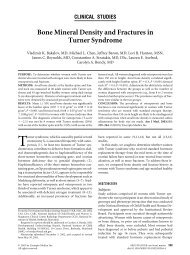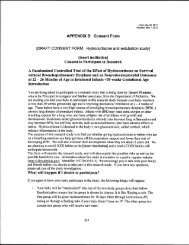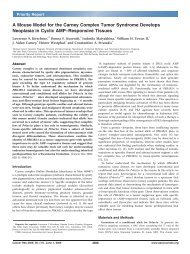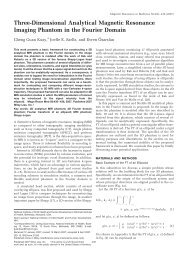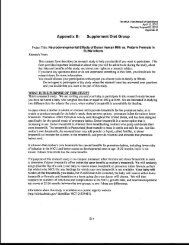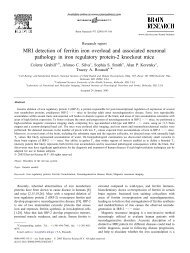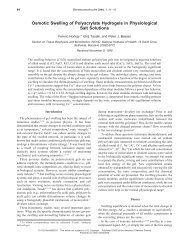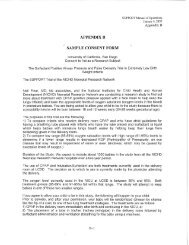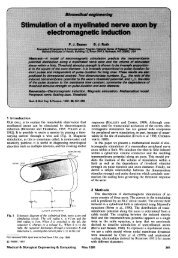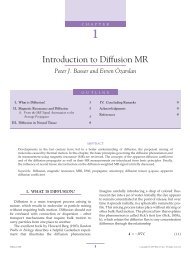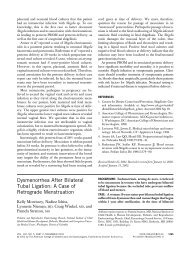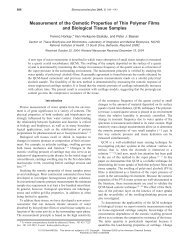The lentiginoses: cutaneous markers of systemic disease and a ...
The lentiginoses: cutaneous markers of systemic disease and a ...
The lentiginoses: cutaneous markers of systemic disease and a ...
Create successful ePaper yourself
Turn your PDF publications into a flip-book with our unique Google optimized e-Paper software.
Downloaded from jmg.bmjjournals.com on 29 June 2006<br />
<strong>The</strong> <strong>lentiginoses</strong>: <strong>cutaneous</strong> <strong>markers</strong> <strong>of</strong> <strong>systemic</strong><br />
<strong>disease</strong> <strong>and</strong> a window to new aspects <strong>of</strong><br />
tumourigenesis<br />
A J Bauer <strong>and</strong> C A Stratakis<br />
J. Med. Genet. 2005;42;801-810; originally published online 15 Jun 2005;<br />
doi:10.1136/jmg.2003.017806<br />
Updated information <strong>and</strong> services can be found at:<br />
http://jmg.bmjjournals.com/cgi/content/full/42/11/801<br />
References<br />
Rapid responses<br />
Email alerting<br />
service<br />
<strong>The</strong>se include:<br />
This article cites 118 articles, 42 <strong>of</strong> which can be accessed free at:<br />
http://jmg.bmjjournals.com/cgi/content/full/42/11/801#BIBL<br />
You can respond to this article at:<br />
http://jmg.bmjjournals.com/cgi/eletter-submit/42/11/801<br />
Receive free email alerts when new articles cite this article - sign up in the box at the<br />
top right corner <strong>of</strong> the article<br />
Topic collections<br />
Articles on similar topics can be found in the following collections<br />
Genetics (3845 articles)<br />
Notes<br />
To order reprints <strong>of</strong> this article go to:<br />
http://www.bmjjournals.com/cgi/reprintform<br />
To subscribe to Journal <strong>of</strong> Medical Genetics go to:<br />
http://www.bmjjournals.com/subscriptions/
Downloaded from jmg.bmjjournals.com on 29 June 2006<br />
801<br />
REVIEW<br />
<strong>The</strong> <strong>lentiginoses</strong>: <strong>cutaneous</strong> <strong>markers</strong> <strong>of</strong> <strong>systemic</strong> <strong>disease</strong> <strong>and</strong><br />
a window to new aspects <strong>of</strong> tumourigenesis<br />
A J Bauer, C A Stratakis<br />
...............................................................................................................................<br />
Familial lentiginosis syndromes cover a wide phenotypic<br />
spectrum ranging from a benign inherited predisposition to<br />
develop <strong>cutaneous</strong> lentigines unassociated with <strong>systemic</strong><br />
<strong>disease</strong>, to associations with several syndromes carrying<br />
increased risk <strong>of</strong> formation <strong>of</strong> hamartomas, hyperplasias,<br />
<strong>and</strong> other neoplasms. <strong>The</strong> molecular pathways involved in<br />
the aetiology <strong>of</strong> these syndromes have recently been more<br />
clearly defined <strong>and</strong> several major cellular signalling<br />
pathways are probably involved: the protein kinase A<br />
(PKA) pathway in Carney complex (CNC), the Ras/Erk<br />
MAP kinase pathway in LEOPARD/Noonan syndromes,<br />
<strong>and</strong> the mammalian target <strong>of</strong> rapamycin pathway (mTOR)<br />
in Peutz-Jeghers syndrome <strong>and</strong> the <strong>disease</strong>s caused by<br />
PTEN mutations. Here we discuss the clinical presentation<br />
<strong>of</strong> these disorders <strong>and</strong> discuss the molecular mechanisms<br />
involved. <strong>The</strong> presence <strong>of</strong> lentigines in these <strong>disease</strong>s<br />
caused by diverse molecular defects is probably more than<br />
an associated clinical feature <strong>and</strong> likely reflects cross talk<br />
<strong>and</strong> convergence <strong>of</strong> signalling pathways <strong>of</strong> central<br />
importance to embryogenesis, neural crest differentiation,<br />
<strong>and</strong> end-organ growth <strong>and</strong> function <strong>of</strong> a broad range <strong>of</strong><br />
tissues including those <strong>of</strong> the endocrine, reproductive,<br />
gastrointestinal, cardiac, <strong>and</strong> integument systems.<br />
...........................................................................<br />
<strong>The</strong> medical examiner in rural Pennsylvania<br />
concluded ‘‘this combination <strong>of</strong> lesions is<br />
best explained by the concept <strong>of</strong> neurocristopathies’’<br />
when finishing his report on the<br />
autopsy <strong>of</strong> a 19 year old heavily freckled man<br />
who died in 1981 due to malignant, metastatic<br />
See end <strong>of</strong> article for (to his brain) pigmented melanotic schwannoma.<br />
<strong>The</strong> young man had been in <strong>and</strong> out <strong>of</strong><br />
authors’ affiliations<br />
.......................<br />
the National Institutes <strong>of</strong> Health (NIH) Clinical<br />
Correspondence to: Center for a variety <strong>of</strong> ailments; he had first been<br />
Dr Constantine A Stratakis, diagnosed with a growth hormone producing<br />
Section on Endocrinology<br />
<strong>and</strong> Genetics, DEB,<br />
tumour but his investigation <strong>and</strong> treatment was<br />
NICHD, NIH, Building 10, complicated by the baffling concurrent diagnosis<br />
CRC, Room I-3330, 10 <strong>of</strong> testicular tumours <strong>and</strong> hypercortisolaemia due<br />
Center Dr., MSC 1103, to adrenal tumours. 1 It was clear that he was<br />
Bethesda, MD 20892,<br />
affected simultaneously by two rare endocrine<br />
USA; stratakc@mail.nih.<br />
gov<br />
conditions, acromegaly <strong>and</strong> Cushing syndrome,<br />
<strong>and</strong> several physicians had noted his many<br />
Revised version received ‘‘freckles’’ <strong>and</strong> other pigmented skin lesions,<br />
18 March 2005<br />
but his <strong>disease</strong> was not actually diagnosed until<br />
Accepted for publication<br />
years later. In 1995, upon reviewing records <strong>of</strong><br />
21 March 2005<br />
Published Online First NIH patients, investigators came across his<br />
15 June 2005<br />
clinical description <strong>and</strong> it became obvious that<br />
....................... he had Carney complex (CNC). CNC belongs to a<br />
J Med Genet 2005;42:801–810. doi: 10.1136/jmg.2003.017806<br />
group <strong>of</strong> disorders that are now slowly but surely<br />
being molecularly elucidated, the familial <strong>lentiginoses</strong><br />
(table 1).<br />
<strong>The</strong> <strong>lentiginoses</strong> share multiple lentigines as<br />
one <strong>of</strong> their most prominent clinical features, the<br />
lentigen being a hamartomatous melanocytic<br />
lesion <strong>of</strong> the skin clinically almost identical to a<br />
freckle but histologically quite distinct. 2 Peutz-<br />
Jeghers syndrome (PJS) is the prototype <strong>of</strong> these<br />
<strong>disease</strong>s which are almost all inherited in an<br />
autosomal dominant manner, have a relatively<br />
high rate <strong>of</strong> de novo cases, <strong>and</strong> predispose to a<br />
variety <strong>of</strong> neoplasms. 2 Laugier-Hunziker syndrome<br />
(LHS), arterial dissections with lentiginosis<br />
(ADL), centr<strong>of</strong>acial <strong>and</strong> partial unilateral<br />
<strong>lentiginoses</strong>, <strong>and</strong> LEOPARD <strong>and</strong> Noonan syndrome<br />
with lentigines (NSL) are other <strong>lentiginoses</strong>.<br />
2 A number <strong>of</strong> related disorders may be<br />
associated with lentigines: Ruvalcaba-Myhre-<br />
Smith or Bannayan-Zonnana syndrome (RMS/<br />
BZS), a condition allelic to Cowden <strong>disease</strong><br />
(CD), 3 Schimke immunoosseous dysplasia, 4<br />
Mulvihill-Smith syndrome (MSS), 5 Watson syndrome,<br />
6 McCune Albright syndrome (MAS), 7 the<br />
two types <strong>of</strong> neur<strong>of</strong>ibromatosis <strong>and</strong> other phacomatoses,<br />
8 multiple endocrine neoplasia 2B<br />
(MEN 2B), <strong>and</strong> nevus phacomatosus pigmentovascularis<br />
(NPP). 9 Xeroderma pigmentosum may<br />
also be associated with solar lentigines; 10 a<br />
number <strong>of</strong> chromosomal conditions <strong>and</strong> syndromes<br />
predisposing to premature aging or<br />
immunodeficiency or associated with DNA <strong>and</strong>/<br />
or chromosomal repair defects may also present<br />
with lentigines. However, in most <strong>of</strong> these<br />
conditions, lentigines are either secondary or<br />
peripheral to the primary lesions <strong>and</strong> do not<br />
represent hamartomatous proliferation <strong>of</strong> the<br />
melanocytes as is the case in the familial<br />
<strong>lentiginoses</strong>. In this review, we focus on the<br />
latter, <strong>and</strong> among them, the syndromes that<br />
have been molecularly elucidated over the last<br />
decade: CNC, PJS/LHS, LEOPARD, <strong>and</strong> NSL <strong>and</strong><br />
the conditions caused by PTEN mutations (RMS/<br />
BZS <strong>and</strong> CD). <strong>The</strong> argument is made that the<br />
affected signalling pathways, protein kinase A<br />
(PKA), Ras/Erk MAP kinase, <strong>and</strong> the mammalian<br />
target <strong>of</strong> rapamycin (mTOR) converge to a<br />
complex system <strong>of</strong> cellular checks <strong>and</strong> balances<br />
that oversee growth, proliferation, <strong>and</strong> differentiation<br />
<strong>of</strong> many cell types; their perturbation<br />
causes a wide array <strong>of</strong> manifestations, including<br />
neoplasms that range from the simple lentigen to<br />
aggressive malignancies.<br />
LENTIGO<br />
Lentigines are <strong>of</strong>ten divided into two broad<br />
categories, simple lentigo <strong>and</strong> solar lentigo.<br />
www.jmedgenet.com
802<br />
Downloaded from jmg.bmjjournals.com on 29 June 2006<br />
Bauer, Stratakis<br />
Table 1 <strong>The</strong> main <strong>lentiginoses</strong>: clinical manifestations <strong>and</strong> genetics<br />
Disease MIM Clinical manifestations Inheritance Locus Gene<br />
Carney complex 160980 Lentigines, PPNAD cardiac <strong>and</strong> skin myxoma schwannomas, acromegaly, AD 17q22–24 PRKAR1A (CNC2)<br />
breast <strong>and</strong> testicular tumours 2p16 (CNC1) ()<br />
Peutz-Jeghers 175200 Lentigines, GI polyps, neoplasia (GI tract, pancreas breast, ovary, uterus) AD 19p13.3 19q LKB1/STK11 ()<br />
LEOPARD 151100 Lentigines, cardiac conduction abnormalities, aneurysms, pulmonic stenosis, AD 12q22-qter PTPN11<br />
cephalo-facial dysmorphism, short stature, sensorineural deafness, mental<br />
retardation, skeletal abnormalities<br />
BRRS/CD 153480 Macrocephaly, lipomatosis, pigmentation <strong>of</strong> the glans penis, mental AD 10q23 PTEN<br />
retardation, vascular malformations<br />
Lentiginosis 151001 Lentigines (centr<strong>of</strong>acial, palmoplantar, trunk) AD Unknown Unknown<br />
151000 As above in addition to mental retardation, skeletal dysraphia AD/sporadic Unknown Unknown<br />
BRRS/CD, Bannayan-Riley-Ruvalcaba/Cowden <strong>disease</strong>; PPNAD, primary pigmented nodular adrenocortical <strong>disease</strong>.<br />
Macules <strong>of</strong> café au lait colour that develop with older age are<br />
also called lentigo but they are clinically <strong>and</strong> genetically<br />
different lesions. In general, lentigines associated with the<br />
genetic <strong>disease</strong>s that are being discussed in this review<br />
develop at a young age, <strong>of</strong>ten increase in number during<br />
adolescence, <strong>and</strong> are not restricted to sun exposed areas,<br />
whereas solar lesions <strong>of</strong>ten develop after the third decade <strong>of</strong><br />
life, increase with advancing age, <strong>and</strong> as the name implies,<br />
are found almost exclusively on sun exposed areas. 11 12 While<br />
the descriptive identification appears fairly straightforward,<br />
the clinical distinction <strong>of</strong> simple lentigo is at times more<br />
difficult, with lesions <strong>of</strong>ten confused with ephelides<br />
(freckles). However, several clinical features <strong>and</strong> histological<br />
differences do exist <strong>and</strong> should aid the clinician in separating<br />
these lesions. Although both types are <strong>of</strong> similar size <strong>and</strong><br />
appearance <strong>and</strong> are <strong>of</strong>ten described as multiple 4–10 mm,<br />
variegated, brown to black macules, lentigines typically do<br />
not darken with sun exposure (as compared to ephelides)<br />
<strong>and</strong> may be distributed on distinct anatomic locations such as<br />
the face (around the eyes <strong>and</strong> on the eyelids, the saddle <strong>of</strong> the<br />
nose, <strong>and</strong> the perioral areas <strong>of</strong> the upper <strong>and</strong> lower lips,<br />
crossing the vermillion border in some <strong>disease</strong>s), palmoplantar<br />
regions <strong>of</strong> the h<strong>and</strong>s <strong>and</strong> feet, breast nipples, buttocks <strong>and</strong><br />
genital region (labial, vaginal mucosa, prepuce, <strong>and</strong> penile<br />
mucosa <strong>and</strong> skin), <strong>and</strong> less commonly other inner mucosal<br />
surfaces (buccal <strong>and</strong> anal mucosa, <strong>and</strong>/or the conjunctivae,<br />
especially the inner <strong>and</strong> outer canthal areas). 2 3 Histologically,<br />
while there is some overlap with freckles, lentigines show<br />
prominent rete ridges <strong>and</strong> melanocytic hyperplasia. In the<br />
case <strong>of</strong> ephelides <strong>and</strong> solar lentigines, increased pigmentation<br />
results from donation <strong>of</strong> pigment from otherwise normal<br />
(albeit stimulated) melanocytes to adjacent keratinocytes.<br />
2 11 12 Clinically, lesions on mucosal surfaces, in particular<br />
the lacrimal caruncle <strong>of</strong> the eye, <strong>and</strong> lesions that cross<br />
the vermilion border <strong>of</strong> the lips are <strong>of</strong> particular importance<br />
as pigmented lesions found in these locations are <strong>of</strong>ten<br />
heralding features <strong>of</strong> the familial lentiginosis syndromes that<br />
are associated with <strong>systemic</strong> <strong>disease</strong>.<br />
BENIGN LENTIGINOSES<br />
Centr<strong>of</strong>acial neurodysraphic (Mendelian Inheritance in Man<br />
(MIM) 151000) 13 <strong>and</strong> patterned (MIM 151001) <strong>lentiginoses</strong><br />
describe two inheritable conditions that, in keeping with all<br />
familial <strong>lentiginoses</strong> syndromes, follow autosomal dominant<br />
(AD) inheritance, but in contrast to the other members <strong>of</strong><br />
14 15<br />
this group are not associated with <strong>systemic</strong> <strong>disease</strong>.<br />
Touraine et al described the first syndrome, centr<strong>of</strong>acial<br />
neurodysraphic lentiginosis, reporting on a group <strong>of</strong> 32<br />
patients from 17 families with early onset <strong>of</strong> facial lentigines,<br />
occasionally found on the upper lip, that faded over time,<br />
which was frequently associated with mental retardation. 14 In<br />
1989, O’Neil <strong>and</strong> James described inherited patterned<br />
lentiginosis: what distinguished this group <strong>of</strong> patients was<br />
the increased incidence in the African American population<br />
<strong>and</strong> the description <strong>of</strong> lentigines not only limited to the facial<br />
region but involving the h<strong>and</strong>s, elbows, <strong>and</strong> buttocks as<br />
well. 16 Interestingly, neither <strong>of</strong> these syndromes are asso<br />
16 17<br />
Several<br />
ciated with lesions <strong>of</strong> the oral mucosa. other<br />
reports <strong>of</strong> multiple <strong>lentiginoses</strong> syndromes have since been<br />
published, but the significance <strong>of</strong> these syndromes, <strong>and</strong><br />
potential overlap with other previously described syndromes,<br />
17 18<br />
is as yet unknown.<br />
CARNEY COMPLEX<br />
<strong>The</strong> association <strong>of</strong> myxomas, spotty skin pigmentation<br />
(lentigines), <strong>and</strong> endocrine overactivity was first reported<br />
by Dr J Aidan Carney in 1985 <strong>and</strong> subsequently designated as<br />
CNC by Bain in 1986 19 <strong>and</strong> Carney syndrome by MIM 13 in<br />
1994. With the report <strong>of</strong> this new syndrome it was realised<br />
that the majority <strong>of</strong> patients previously characterised under<br />
the separate diagnoses <strong>of</strong> LAMB (lentigines, atrial myxoma,<br />
muco<strong>cutaneous</strong> myxoma, blue nevi) <strong>and</strong> NAME (nevi, atrial<br />
myxoma, myxoid neur<strong>of</strong>ibroma, ephelides) would now be<br />
more appropriately classified under CNC. <strong>The</strong> diagnosis <strong>of</strong><br />
CNC is made if two <strong>of</strong> the main manifestations <strong>of</strong> the<br />
syndrome are present 20 ; these need to be confirmed by<br />
histology, biochemical testing, or imaging. Alternatively, the<br />
diagnosis is made when one <strong>of</strong> the criteria is present <strong>and</strong> the<br />
patient is a carrier <strong>of</strong> a known inactivating mutation <strong>of</strong> the<br />
PRKAR1A gene (see ‘‘Molecular mechanism’’ section below<br />
for discussion). 20–22<br />
<strong>The</strong> most common features <strong>of</strong> CNC include spotty skin<br />
pigmentation (fig 1) (lentigines, freckling, café au lait spots,<br />
<strong>and</strong> blue nevi), myxomas <strong>of</strong> the heart, skin, <strong>and</strong> breast, <strong>and</strong><br />
primary pigmented nodular adrenal cortical <strong>disease</strong> (PPNAD)<br />
associated with an atypical form <strong>of</strong> Cushing syndrome<br />
(CS). 23 25 <strong>The</strong> breadth <strong>of</strong> involved organs in CNC is quite<br />
unique; CNC is both a multiple endocrine neoplasia (MEN)<br />
(along with MEN-1 <strong>and</strong> -2) <strong>and</strong> a cardio<strong>cutaneous</strong> syndrome<br />
(along with LEOPARD <strong>and</strong> similar conditions). Of the non<strong>cutaneous</strong><br />
lesions found in CNC, cardiac myxomas are the<br />
22 24<br />
most common. <strong>The</strong>se tumours tend to be <strong>of</strong> a more<br />
aggressive nature when compared to sporadic, non-CNCassociated<br />
myxomas: unlike the latter, the former may be in<br />
any cardiac chamber <strong>and</strong> may present multiple times,<br />
starting at a very young age (even in infancy) <strong>and</strong> without<br />
any predilection for gender (sporadic myxomas are more<br />
common in older women <strong>and</strong> almost always occur in the left<br />
atrium as single one-time tumours). 22 Historically, cardiac<br />
myxomas have been reported to be responsible for more than<br />
50% <strong>of</strong> the <strong>disease</strong> specific mortality among CNC patients. 24<br />
Endocrine gl<strong>and</strong> involvement can result in growth hormone<br />
(GH) secreting pituitary adenomas, thyroid gl<strong>and</strong><br />
<strong>disease</strong>, corticotropin (ACTH) independent CS secondary to<br />
PPNAD, <strong>and</strong> testicular tumours, in particular, large cell<br />
calcifying Sertoli cell tumours (LCCSCT). 20–24 Overall, PPNAD<br />
is the most common endocrine lesion <strong>and</strong> causes the greatest<br />
degree <strong>of</strong> endocrine associated morbidity (discussed in more<br />
www.jmedgenet.com
Familial <strong>lentiginoses</strong><br />
Downloaded from jmg.bmjjournals.com on 29 June 2006<br />
803<br />
Figure 1 Pigmentation in Carney complex. (A) A blue nevus on the<br />
cheek <strong>of</strong> a patient with the complex. (B) Lentigines on the sides <strong>of</strong> the<br />
nose. (C) Lentigines on the vermillion border <strong>of</strong> the lips <strong>and</strong> the mucosa.<br />
(D) Blue nevus on the dorsal surface <strong>of</strong> the h<strong>and</strong>. Unusual pigmented<br />
lesions in patients with Carney complex may occur everywhere <strong>and</strong> are<br />
not unusual even in newborns with the <strong>disease</strong>. (<strong>The</strong>se photographs are<br />
reproduced with consent.)<br />
detail below). 24 In male patients, however, the occurrence <strong>of</strong><br />
LCCSCT may supersede PPNAD in number, but not in<br />
morbidity, as it is typically a benign lesion most <strong>of</strong>ten<br />
diagnosed during routine testicular ultrasound when microcalcifications<br />
are found. 24 Leydig cell tumours <strong>and</strong> adrenal<br />
rests have also been reported. 24 Ovarian cysts are <strong>of</strong>ten found<br />
by sonographic examination as multiple hypoechoic lesions<br />
<strong>and</strong> although usually clinically insignificant, they may<br />
20 26 27<br />
occasionally progress to ovarian carcinoma.<br />
Thyroid gl<strong>and</strong> <strong>disease</strong> spans the spectrum from nodular<br />
<strong>disease</strong> to carcinoma, but in contrast to pituitary <strong>and</strong> adrenal<br />
pathology, there does not appear to be an increased risk <strong>of</strong><br />
hyper- or hypothyroidism. By sonographic examination,<br />
more than 60% <strong>of</strong> children <strong>and</strong> adults with CNC will be<br />
found to have cystic or multinodular <strong>disease</strong>. 28 On biopsy,<br />
follicular adenoma is the most common finding, whereas<br />
thyroid cancer, follicular or papillary, may develop in up to<br />
10% <strong>of</strong> CNC patients with preexisting thyroid pathology. 28 Of<br />
note, recent examination for loss <strong>of</strong> heterozygosity (LOH) at<br />
the CNC locus on chromosome 17 (17q22–24) in sporadic<br />
thyroid cancer has found increased loss <strong>of</strong> this region,<br />
supporting the hypothesis that thyroid tissue is susceptible to<br />
tumourigenesis induced by PRKAR1A loss <strong>of</strong> function. 29<br />
Molecular mechanism<br />
Genetic linkage analysis has revealed two distinct loci for<br />
CNC, one on chromosome 2p16 (CNC2) <strong>and</strong> the other on<br />
chromosome 17q22–24 (CNC1). 30 31 Inactivating mutations <strong>of</strong><br />
the gene encoding the protein kinase A type I-a regulatory<br />
(R1a) subunit (PRKAR1A) were identified in patients mapping<br />
to chromosome 17 <strong>and</strong> analysis <strong>of</strong> 53 <strong>of</strong> the 70 kindreds<br />
registered in the National Institutes <strong>of</strong> Health-Mayo Clinic<br />
collection has revealed that 28 out <strong>of</strong> the 53 (52.8%) have<br />
mutations at the CNC1 locus. 32 <strong>The</strong> gene responsible for CNC<br />
at the chromosome 2p16 locus is unknown <strong>and</strong> there is at<br />
least one large kindred with CNC that does not map to either<br />
the CNC1 or CNC2 locus. 32 At this point, there are no clear<br />
phenotypic differences between families mapping to one or<br />
the other locus.<br />
<strong>The</strong> role <strong>of</strong> R1a in human tumourigenesis has been<br />
explored in several different cancer tissues <strong>and</strong> cell lines.<br />
Enhanced expression <strong>of</strong> R1a has been shown to play a role in<br />
colorectal, renal, breast, <strong>and</strong> ovarian cancer, <strong>and</strong> malignant<br />
osteoblasts, <strong>and</strong> may be associated with more advanced<br />
<strong>disease</strong>. 32–39 <strong>The</strong> notion <strong>of</strong> reduced R1a activity had not been<br />
investigated prior to the discovery <strong>of</strong> it being the protein that<br />
was defective in CNC; CNC represents the first identified<br />
human <strong>disease</strong> associated with a mutation <strong>of</strong> the PKA<br />
heterotetramer. <strong>The</strong> majority <strong>of</strong> mutations in the PRKAR1A<br />
gene result in premature stop codons, with the most frequent<br />
mutations found in exons 2, 4, <strong>and</strong> 6. 40 Predicted mutant<br />
protein products are not found in affected cells secondary to<br />
nonsense mRNA mediated decay (NMD) <strong>of</strong> the mutant<br />
sequence. 31 Biochemically, loss <strong>of</strong> R1a leads to increased<br />
cAMP stimulated total kinase activity, 31 thought to be<br />
secondary to up regulation <strong>of</strong> other components <strong>of</strong> the PKA<br />
tetramer, 41 including both type I (PRKAR1B) <strong>and</strong> type II<br />
(PRKAR2A or PRKAR2B) subunits, in a tissue dependent<br />
manner, 20 but how this leads to increased tumourigenesis is<br />
currently unknown.<br />
Initial data supported the role <strong>of</strong> PRKAR1A as a ‘‘classic’’<br />
tumour suppressor gene with tumours from CNC patients<br />
exhibiting germline mutations <strong>and</strong> subsequent LOH at the<br />
PRKAR1A locus; however, it now appears that haploinsufficiency<br />
<strong>of</strong> PRKAR1A may be sufficient for phenotypic expression<br />
<strong>of</strong> increased PKA activity 42 <strong>and</strong> the development <strong>of</strong><br />
certain tumours, such as eyelid myxomas. 43 This concept is<br />
exemplified in animal models <strong>of</strong> CNC: whereas mice<br />
homozygous for R1a deletions die early in utero, 44 transgenic<br />
mice with heterogeneous expression <strong>of</strong> an antisense transgene<br />
for exon 2 <strong>of</strong> PRKAR1A exhibit many <strong>of</strong> the phenotypic<br />
characteristics <strong>of</strong> CNC patients, including thyroid follicular<br />
hyperplasia <strong>and</strong> non-dexamethasone suppressible hypercortisolism.<br />
Not all <strong>of</strong> these lesions exhibited consistent<br />
45 46<br />
46 49<br />
losses <strong>of</strong> the normal R1a allele.<br />
Examination <strong>of</strong> the mechanisms associated with loss <strong>of</strong><br />
R1a, increased PKA activity, <strong>and</strong> tumourigenesis are currently<br />
underway. PKA is a ubiquitous serine-threonine kinase<br />
intimately involved in the regulation <strong>of</strong> cell growth, including<br />
a potential role in chromosome stability. 21 <strong>The</strong> cross talk<br />
between signal transduction pathways <strong>and</strong> the tissue specific<br />
effects <strong>of</strong> altered PKA function are inherently quite complex,<br />
reflected by at times conflicting data. For example, alterations<br />
<strong>of</strong> 17q <strong>and</strong>/or the PRKAR1A locus have been found in<br />
both sporadic adrenal <strong>and</strong> thyroid cancers, yet allelic loss <strong>of</strong><br />
17q in cardiac <strong>and</strong> skin myxomas from CNC patients, with<br />
known germline PRKAR1A mutations, have not been<br />
21 43<br />
Interestingly,<br />
found. CNC myxomas appear to have a<br />
more aggressive nature when compared to sporadic, non<br />
CNC-associated myxomas, as discussed previously.<br />
<strong>The</strong> physiological impact <strong>of</strong> PRKAR1A inactivating mutations<br />
has been most thoroughly studied in PPNAD, a rare<br />
form <strong>of</strong> ACTH independent CS, which is present in<br />
approximately one third <strong>of</strong> CNC patients. PPNAD <strong>of</strong>ten<br />
presents in an indolent fashion <strong>and</strong> may be difficult to<br />
diagnose due to an intermittent or cyclical nature <strong>of</strong> the<br />
associated hypercortisolism. 22 Diagnosis is established using<br />
the 6 day Liddle test as patients with PPNAD show a<br />
paradoxical rise in the 24 h urinary free cortisol <strong>and</strong>/or 17<br />
hydroxysteroids <strong>of</strong> more than 50% on the second day <strong>of</strong> high<br />
dose dexamethasone administration. 24 While this response<br />
appears to be pathognomonic for PPNAD, it does not appear<br />
to be dependent on the presence <strong>of</strong> PRKAR1A mutations as<br />
comparative in vitro studies between PPNAD cell lines with<br />
<strong>and</strong> without R1a deficiency showed increased cortisol<br />
secretion in response to dexamethasone associated with<br />
increased expression <strong>of</strong> the glucocorticoid receptor. 47 <strong>The</strong><br />
underlying mechanism for this response is not known.<br />
Additional studies aimed at elucidating the inter-relationship<br />
between PRKAR1A status, altered PKA activity, <strong>and</strong><br />
cellular metabolism are being aggressively pursued.<br />
Microarray analysis <strong>of</strong> R1a antisense targeted tumour cells<br />
www.jmedgenet.com
804<br />
Downloaded from jmg.bmjjournals.com on 29 June 2006<br />
Bauer, Stratakis<br />
Figure 2 Features <strong>of</strong> Noonan/LEOPARD syndromes. (A) Pigmented<br />
lesions on the face can mimic those <strong>of</strong> patients with Carney complex, but<br />
they tend not to be present on the lips or periorally; they occur mostly as<br />
single darkly pigmented spots <strong>and</strong> look less like freckles. (B) Lentigines on<br />
the shoulders <strong>and</strong> the back can be extensive; winged scapulae is also an<br />
evident deformity in this patient. (C) Skeletal deformities, scoliosis <strong>and</strong><br />
hyperextensibility, like that shown in this image, are not unusual in<br />
patients with this condition. (<strong>The</strong>se photographs are reproduced with<br />
consent.)<br />
has recently been shown to change expression <strong>of</strong> more than<br />
240 genes suggesting that altered regulation <strong>of</strong> a significant<br />
number <strong>of</strong> downstream targets is likely to contribute to the<br />
CNC phenotype. 48 Investigation <strong>of</strong> one <strong>of</strong> the signalling<br />
pathways, the mitogen activated protein kinase (MAPK) ERK<br />
1/2 pathway, typically inhibited by PKA in many cells, has<br />
recently been reported. In this report, the lymphocytes from<br />
CNC patients with known PRKAR1A mutations showed<br />
altered PKA activity <strong>and</strong> increased ERK 1/2 phosphorylation.<br />
42 Cell metabolism <strong>and</strong> cell proliferation studies suggested<br />
that altered PKA activity is associated with reversal <strong>of</strong><br />
PKA mediated inhibition <strong>of</strong> the MAPK pathway resulting in<br />
increased cell proliferation. 42<br />
LEOPARD SYNDROME<br />
LEOPARD is also <strong>of</strong>ten referred to as multiple lentigines<br />
syndrome (MLS). <strong>The</strong> acronym, which also describes the<br />
pattern <strong>of</strong> pigmentation (fig 2), was suggested first by Gorlin<br />
et al in 1969 50 <strong>and</strong> reflects the components <strong>of</strong> this<br />
cardio<strong>cutaneous</strong> disorder: lentigines, electrocardiographic<br />
conduction defects, ocular hypertelorism, pulmonary stenosis,<br />
abnormal genitalia, retardation <strong>of</strong> growth, <strong>and</strong> sensorineural<br />
deafness. 51 52 <strong>The</strong> diagnosis is established if multiple lentigines<br />
are present in association with at least two other<br />
features; if lentigines are absent, a first degree relative<br />
affected with LEOPARD syndrome <strong>and</strong> three <strong>of</strong> the other six<br />
features are needed for diagnosis. 52<br />
As in CNC patients, the lentigines usually develop in<br />
childhood <strong>and</strong> are <strong>of</strong>ten the first clinical manifestation to<br />
appear 52 ; they are located primarily on the face <strong>and</strong> upper<br />
trunk, less commonly involving the oral mucosa, extremities,<br />
genitalia, or conjuctiva <strong>of</strong> the eye. 53 <strong>The</strong> appearance <strong>and</strong><br />
distribution <strong>of</strong> the lentigines are very similar to CNC, as is the<br />
histological appearance, including melanocytic hyperplasia<br />
<strong>and</strong> elongation <strong>of</strong> the rete ridges. One important difference is<br />
the absence <strong>of</strong> pigmented spots along the vermilion border <strong>of</strong><br />
the lips, a finding that is characteristic in CNC <strong>and</strong> PJS<br />
patients. Also, skeletal abnormalities, onychodystrophy, <strong>and</strong><br />
hyperelastic skin, which are <strong>of</strong>ten found in LEOPARD<br />
52 53<br />
syndrome patients, are not common in other <strong>lentiginoses</strong>.<br />
<strong>The</strong> crani<strong>of</strong>acial features <strong>of</strong> LEOPARD syndrome are generally<br />
coarse <strong>and</strong> include low set <strong>and</strong> posteriorly rotated ears,<br />
hypertelorism with or without ptosis, webbed neck, <strong>and</strong><br />
m<strong>and</strong>ibular prognathism. 52 <strong>The</strong>se features, combined with an<br />
increased incidence <strong>of</strong> pulmonic stenosis, show significant<br />
phenotypic overlap with Noonan syndrome (MIM 163950);<br />
furthermore, hyperelasticity <strong>and</strong> other features partially<br />
overlap with Ehlers-Danlos syndrome subtypes <strong>and</strong> the<br />
arterial dissections with lentiginosis (ADL) syndrome (see<br />
below). 52<br />
Morbidity <strong>and</strong> mortality associated with LEOPARD syndrome<br />
are dependent on the extent <strong>of</strong> cardiac <strong>disease</strong>.<br />
Multiple congenital heart defects have been reported to<br />
include not only pulmonic stenosis (present in 40% <strong>of</strong><br />
patients) but also subaortic <strong>and</strong> subpulmonic stenosis, <strong>and</strong><br />
hypertrophic obstructive cardiomyopathy. 53 In addition, conduction<br />
abnormalities are common <strong>and</strong> whether they are a<br />
primary defect, or secondary to structural abnormalities, may<br />
result in sudden cardiac death. 54 More recently, a predisposition<br />
to widespread, recurrent polyaneurysms has been<br />
reported in a patient with genetically confirmed LEOPARD<br />
syndrome. 55 Although unproven, it is interesting to speculate<br />
whether patients previously diagnosed with the ADL disorder<br />
(MIM 600459) may be more appropriately reclassified as<br />
having a variant <strong>of</strong> LEOPARD syndrome; to our knowledge,<br />
these patients have not had genetic testing. 56<br />
Molecular mechanism<br />
<strong>The</strong> clinical similarities between LEOPARD <strong>and</strong> Noonan<br />
syndrome (NS), <strong>and</strong> the series <strong>of</strong> patients with both<br />
lentigines <strong>and</strong> NS-like features (NSL), raised the question<br />
whether these syndromes could be allelic disorders with<br />
varied clinical expression. Some <strong>of</strong> the patients with NSL had<br />
in fact Watson syndrome, a condition that is allelic to<br />
neur<strong>of</strong>ibromatosis type I. Still, LEOPARD, NS, <strong>and</strong> NSL share<br />
similar crani<strong>of</strong>acial features, an increased incidence <strong>of</strong><br />
sensorineural deafness <strong>and</strong> cryptorchidism, <strong>and</strong> associated<br />
pulmonic stenosis. In total, up to 10% <strong>of</strong> NS patients have<br />
lentigines. 57 In 1996, mutations in the PTPN11 gene<br />
(12q24.1), encoding the non-receptor tyrosine protein tyrosine<br />
phosphatase Shp-2 (Src homology 2 domain containing<br />
protein tyrosine phosphatase-2), were found to be the cause<br />
<strong>of</strong> NS in 50% <strong>of</strong> patients. 58 In 2002, independent research<br />
groups published reports linking PTPN11 mutations to<br />
59 60<br />
LEOPARD syndrome.<br />
Shp-2 is an important intermediate in several signalling<br />
pathways involved in modulating cellular proliferation,<br />
differentiation, <strong>and</strong> migration. Vertebrates have two Shp<br />
proteins, Shp-1 <strong>and</strong> Shp-2, both having two N-terminal<br />
domains, N-SH2 <strong>and</strong> C-SH2, a catalytic protein-tyrosine<br />
phosphatase (PTP) domain, <strong>and</strong> a C-terminal tail. 61 Shp2 is a<br />
key regulatory protein in the receptor tyrosine kinase (RTK)<br />
signalling pathways whose primary role is to down regulate<br />
GTPase activating proteins (GAP) resulting in activation <strong>of</strong><br />
Ras. 61 In the basal state, the N-SH2 domain <strong>of</strong> Shp-2 exhibits<br />
an inhibitory role over the phosphatase activity by allosterically<br />
blocking the binding domain <strong>of</strong> PTP. 61 To date, the<br />
PTPN11 mutations that have been described in both NS <strong>and</strong><br />
LEOPARD are believed to be gain <strong>of</strong> function mutations<br />
leading to dysregulated phosphatase activity with subsequent<br />
increased inhibition <strong>of</strong> GTPase which in turn leads to<br />
61 62<br />
increased Ras activity. In keeping with this, in vitro<br />
studies <strong>of</strong> haematopoietic cell lines harbouring PTPN11<br />
mutations show increased proliferation rates <strong>and</strong> reduced<br />
growth factor requirements. 62<br />
How these abnormalities result in human <strong>disease</strong> <strong>and</strong> what<br />
intermediary molecules <strong>and</strong> additional downstream targets<br />
<strong>of</strong> Shps are affected by mutations <strong>of</strong> the PTPN11 gene are as<br />
www.jmedgenet.com
Familial <strong>lentiginoses</strong><br />
Downloaded from jmg.bmjjournals.com on 29 June 2006<br />
805<br />
Figure 3 Pigmentation in Peutz-Jeghers syndrome looks similar to that in Carney complex except that single lesions tend to be larger <strong>and</strong> more<br />
pigmented. (A) Lentigines on the vermillion border <strong>of</strong> the lips <strong>and</strong> a darkly pigmented lesion on the mucosa (arrow). (B) Freckling around the eyes with<br />
multiple lentigines. (C, D). Pigmented lesions in the oral mucosa are frequent in patients with this syndrome, perhaps more frequent than in any other<br />
lentiginosis. (<strong>The</strong>se photographs are reproduced with consent.)<br />
yet poorly understood. It is <strong>of</strong> interest to note, however, that<br />
SHP-2 has mitogenic effects on vascular smooth muscle <strong>and</strong><br />
interacts with several key elements <strong>of</strong> angiogenesis, including<br />
the angiopoietin-1 receptor <strong>and</strong> the signalling cascade <strong>of</strong><br />
vascular endothelial growth factor (VEGF). 54<br />
Accumulating evidence suggests that certain germline<br />
PTPN11 mutations play a key role in certain manifestations<br />
<strong>of</strong> LEOPARD, NS, <strong>and</strong>/or NSL, such as the malformations <strong>of</strong><br />
the cardiovascular system <strong>and</strong> predisposition to certain<br />
malignancies. 54 For example, exon 8 mutations were more<br />
commonly associated with pulmonary valve stenosis, <strong>and</strong><br />
exon 7 <strong>and</strong> 12 mutations were more frequently associated<br />
with hypertrophic cardiomyopathy, whereas those <strong>of</strong> exon 3<br />
were associated with atrial septal defects. 63 Certain mutations<br />
are also associated with malignancies in both the germline<br />
<strong>and</strong> somatic state: although neoplasms are uncommon in<br />
LEOPARD patients, children with NS have an increased<br />
incidence <strong>of</strong> haematological disorders, including juvenile<br />
myelomonocytic leukaemia (JMML). 62 Recent studies indicated<br />
that in addition to mutations in the Ras oncogene <strong>and</strong><br />
inactivating mutations <strong>of</strong> NF1, in a mutually exclusive<br />
manner, 25–30% <strong>of</strong> JMML cases harboured somatic PTPN11<br />
mutations. 62 64 <strong>The</strong>se mutations are found in similar locations<br />
as those found in LEOPARD <strong>and</strong> NS, but resulted in different<br />
amino acid substitutions. 61 This apparent genotype-phenotype<br />
correlation was further supported by the observations<br />
made in a transgenic mouse model which expressed a<br />
heterozygous NS associated PTPN11 mutation (D61G) developing<br />
short stature, crani<strong>of</strong>acial abnormalities, myeloproliferative<br />
<strong>disease</strong>, <strong>and</strong> multiple cardiac defects. 65<br />
PEUTZ-JEGHERS SYNDROME<br />
PJS is a disorder characterised by muco<strong>cutaneous</strong> lentigines<br />
(lips, buccal mucosa), gastrointestinal (GI) hamartomatous<br />
polyps (affecting the small bowel, stomach, <strong>and</strong> large colon),<br />
<strong>and</strong> an increased risk <strong>of</strong> developing early onset adenocarcinoma<br />
<strong>of</strong> the GI tract, as well as tumours <strong>of</strong> the pancreas,<br />
breast, thyroid, <strong>and</strong> reproductive organs. 66 67 <strong>The</strong>re is significant<br />
clinical overlap between PJS <strong>and</strong> CNC to the point<br />
that some patients with CNC in the NIH series had been<br />
diagnosed with PJS 68 (the opposite is less frequent since PJS<br />
is a widely known condition, whereas CNC was only recently<br />
described). As in CNC, patients with PJS may have lentigines<br />
<strong>of</strong> the lips, buccal mucosa, genitals, or the h<strong>and</strong>s <strong>and</strong> feet<br />
(fig 3), which tend to fade in older age 2 (an important<br />
consideration in the evaluation <strong>of</strong> the older patient with<br />
multiple hamartomatous GI polyps) <strong>and</strong> a number <strong>of</strong> other<br />
skin lesions (mostly compound but also blue <strong>and</strong> Spitz nevi),<br />
thyroid tumours, <strong>and</strong> an increased incidence <strong>of</strong> gonadal<br />
tumours. Most males with PJS, as patients with CNC, have<br />
upon sonographic examination testicular micro-calcifications<br />
which reflect the presence <strong>of</strong> multiple foci <strong>of</strong> large cell<br />
calcifying Sertoli cell tumours (LCCSCTs). Leydig cell<br />
tumours are less frequent, as in CNC. LCCSCTs may express<br />
aromatase <strong>and</strong> lead to precocious puberty <strong>and</strong> gynaecomastia,<br />
68 clinical findings that are more common in boys with PJS<br />
than in those with CNC. Females with PJS develop a variety<br />
<strong>of</strong> gynaecological neoplasms; their high prevalence <strong>and</strong><br />
histological subtypes are at variance with those <strong>of</strong> women<br />
with CNC. 27<br />
It was recently reported that the cumulative life long risk<br />
for developing cancer in a patient with PJS exceeds 90%. 66<br />
<strong>The</strong>re does not appear to be a risk difference between<br />
genders, with the exception <strong>of</strong> gonadal malignancies <strong>and</strong><br />
breast cancer, which are far more common in females. 69 <strong>The</strong><br />
mean age <strong>of</strong> diagnosis <strong>of</strong> a first cancer was 42.9¡10.2 years<br />
in one study. 63 <strong>The</strong> most recent study <strong>of</strong> 240 patients with PJS<br />
(188 familial <strong>and</strong> 52 sporadic cases were included), all with<br />
confirmed genetic defects, showed an age dependent risk <strong>of</strong><br />
developing cancer as follows: 1% at age 20, 3% at 30, 19% at<br />
40, 32% at 50, 63% at 60, <strong>and</strong> 81% at 70 years. 69 Overall, 54<br />
malignancies were diagnosed in 47 carriers; GI (oesophageal,<br />
stomach, small bowel, colon, rectum, <strong>and</strong> pancreas) <strong>and</strong><br />
breast cancers were the most common. Compared to the<br />
general population, the risk <strong>of</strong> developing colorectal <strong>and</strong><br />
breast cancer in PJS by age 60 was 42% <strong>and</strong> 32% versus 1%<br />
<strong>and</strong> 5%, respectively. 69 Thus, breast cancer risks in women<br />
with PJS are comparable to those <strong>of</strong> women with either<br />
BRCA1 or BRCA2 mutations. <strong>The</strong> optimal time to initiate GI<br />
<strong>and</strong> breast cancer surveillance is still somewhat controversial,<br />
although most agree that GI screening (by endoscope,<br />
colonoscopy, <strong>and</strong> abdominal CT) <strong>and</strong> breast examinations<br />
with reproductive tract screening (by pelvic ultrasound,<br />
cervical cytology, <strong>and</strong> serum CA125 levels) should start after<br />
age 20 <strong>and</strong> 25, respectively. 69<br />
www.jmedgenet.com
806<br />
Downloaded from jmg.bmjjournals.com on 29 June 2006<br />
Bauer, Stratakis<br />
Figure 4 Two independent pathways appear to be critically important in regulating cell growth in response to nutrient supply <strong>and</strong> mitogenic<br />
stimulation: (i) the PKA/PRKAR1A-LKB1 tumour suppressor protein pathway, acting via AMPK, <strong>and</strong> (ii) the PI3K/AKT pathway. Recent evidence<br />
suggests that the tumour suppressor gene complex, TSC1/TSC2, orchestrates the signal from both pathways to the downstream target, mTOR, which in<br />
turn regulates the ribosomal protein S6 <strong>and</strong> 4EBP-1, a repressor <strong>of</strong> the translational initiation factor eIF4E. In this model, at times <strong>of</strong> nutrient stress<br />
LKB1/AMPK activation <strong>of</strong> the TSC1/TSC2 complex results in inhibition <strong>of</strong> mTOR <strong>and</strong> a decrease in protein synthesis. Under stimulation <strong>of</strong> mitogenic<br />
pathways, PI3K phosphorylates PIP2 to PIP3 resulting in recruitment <strong>of</strong> AKT to the membrane where it is activated by PDK1. Activated AKT inhibits the<br />
TSC1/TSC2 tumour suppressor complex leading to increased mTOR activity. In the later pathway, PTEN antagonises PIP3 action through<br />
dephosphorylation, <strong>and</strong> thus provides an ‘‘<strong>of</strong>f’’ switch for regulating mitogenic pathway induced cellular growth <strong>and</strong> proliferation. Cross talk <strong>of</strong> several<br />
other pathways appears to play important regulatory roles in the <strong>lentiginoses</strong> syndromes to include the Ras/MAPK pathway in the regulation <strong>of</strong><br />
translation, the LKB1 pathway in cellular polarity, the AKT pathway (as well as the TSC1/TSC2 complex) in the regulation <strong>of</strong> the Wnt/GSK3b/b-Cat<br />
pathway, <strong>and</strong> the BMP pathway in the regulation <strong>of</strong> PTEN (see text for further discussion). Lastly, both PTEN <strong>and</strong> mTOR appear to have negative<br />
regulatory effects on VEGF through loss <strong>of</strong> stabilisation <strong>of</strong> the hypoxia inducible transcription factor 1 (HIF1).<br />
Molecular mechanism<br />
In 1998, two independent reports identified germline mutations<br />
in the gene LKB1/STK11 on 19p13.3, coding for a serine/<br />
threonine kinase, as the cause <strong>of</strong> PJS in most (but not all)<br />
patients. 70 71 To date mutations in LKB1 can be found in only<br />
30–80% <strong>of</strong> patients; linkage to other loci, including 19q13.4,<br />
has also been reported but the causative gene(s) have not<br />
been identified. 72 73 LKB1 appears to function as a classic<br />
tumour suppressor following Knudson’s two hit hypothesis,<br />
at least as far as the development <strong>of</strong> GI neoplasms is<br />
concerned. Interestingly, LKB1 also appears to play a role in<br />
two additional key regulatory pathways, involved in controlling<br />
the polarity <strong>of</strong> epithelial cells <strong>and</strong> as the master regulator<br />
<strong>of</strong> AMP dependent kinase, the central sensor <strong>of</strong> cellular ATP<br />
levels <strong>and</strong> key regulator <strong>of</strong> cellular energy consumption 74–77 ;<br />
LKB1 may also be interacting with PRKAR1A, <strong>and</strong> is<br />
phosphorylated by PKA (fig 4).<br />
<strong>The</strong> <strong>lentiginoses</strong> <strong>and</strong> the mTOR pathway<br />
It has recently been suggested that LKB1 defects lead to<br />
dysregulation <strong>of</strong> the downstream target mTOR, the mammalian<br />
target <strong>of</strong> rapamycin, a key regulator <strong>of</strong> protein translation.<br />
78 79 mTOR is a highly conserved serine/threonine kinase<br />
that mediates cellular growth by sensing information on the<br />
cellular energy status <strong>and</strong> mitogenic signals <strong>and</strong> then<br />
coordinating the activity <strong>of</strong> the translational machinery <strong>of</strong><br />
the cell through regulation <strong>of</strong> the ribosomal protein S6<br />
kinases (S6Ks) <strong>and</strong> the eukaryotic translational initiation<br />
factor 4E (eIF4E) binding proteins (4E-BPs). 80 Dysregulated<br />
activation <strong>of</strong> mTOR is believed to allow growth <strong>of</strong> cells to<br />
occur at times <strong>of</strong> reduced nutrient or energy supply <strong>and</strong><br />
independently <strong>of</strong> mitogenic stimuli with the ‘‘uncoupling’’<br />
hypothesised to be the underlying mechanism responsible for<br />
the formation <strong>of</strong> hamartomas <strong>and</strong> neoplasia in PJS <strong>and</strong> other<br />
conditions (fig 5). LKB1 plays a fundamental role in<br />
regulating cellular energy metabolism by down regulating<br />
mTOR dependent protein synthesis during times <strong>of</strong> nutrient<br />
stress. 81 This regulatory control is mediated through the direct<br />
activation <strong>of</strong> AMP activated protein kinase (AMPK), a<br />
primary sensor <strong>of</strong> cellular response to reduced ATP levels.<br />
AMPK is activated by a variety <strong>of</strong> stimuli, including oxidative<br />
<strong>and</strong> osmotic damage, hypoxia, <strong>and</strong> hypoglycaemia. 81 Once<br />
activated, AMPK phosphorylates <strong>and</strong> activates tuberin<br />
(encoded by the tumour suppressor TSC2 <strong>and</strong> mutated in<br />
tuberous sclerosis type II), resulting in inhibition <strong>of</strong> mTOR<br />
signalling. 82 At the basal state, LKB1 protects cells from<br />
apoptosis by reducing protein synthesis at times <strong>of</strong> stress.<br />
Loss <strong>of</strong> LKB1 function results in dysregulated mTOR<br />
mediated protein synthesis 74–79 ; in addition, aberrant TSC1/<br />
TSC2 <strong>and</strong>/or mTOR signalling in these cells results in<br />
increased angiogenesis through activation <strong>of</strong> hypoxia inducible<br />
factor 1 (HIF) <strong>and</strong> VEGF. 83 Consistent with the above,<br />
Lkb1 deficient mice develop intestinal hamartomatous<br />
polyps 84 85 <strong>and</strong> hepato-cellular carcinoma. 86 Interestingly,<br />
Lkb1 deficient cells are resistant to Ras induced transformation,<br />
84 as would have been expected from a disruptor <strong>of</strong><br />
mTOR signalling. While these alterations shed light on<br />
aberrant cellular metabolism <strong>and</strong> may explain why cells<br />
without normal LKB1 function show immortalised growth<br />
<strong>and</strong> decreased apoptosis, they do not fully explain the<br />
www.jmedgenet.com
Familial <strong>lentiginoses</strong><br />
Downloaded from jmg.bmjjournals.com on 29 June 2006<br />
807<br />
Figure 5 Loss <strong>of</strong> function <strong>of</strong> the tumour suppressor proteins LKB1 (or its regulator PKA/PRKAR1A) in Peutz-Jeghers syndrome, <strong>and</strong> PTEN <strong>and</strong> BMP in<br />
Cowden syndrome/Banayan-Riley-Ruvalcaba (or TSC1/TSC2 in tuberous sclerosis) leads to a proliferative advantage for the affected cells by<br />
switching on the protein translational machinery <strong>of</strong> the cells which advances cellular growth. In addition, LKB1 is required to maintain an organised,<br />
polarised epithelium in a cell to cell interaction independent manner; loss <strong>of</strong> LKB1 leads to loss <strong>of</strong> cellular polarity <strong>and</strong> loss <strong>of</strong> PTEN function to increased<br />
levels <strong>of</strong> PIP3, increased AKT, mTOR, b-catenin, <strong>and</strong> HIF activity. Accumulating evidence suggests that dysregulated activity <strong>of</strong> mTOR <strong>and</strong> the<br />
downstream effectors S6K1, 4EBP1, <strong>and</strong> HIF, as well as down regulation <strong>of</strong> the GSK3b complex with increased b-Cat activity may be the triggering<br />
mechanism for hamartoma formation in the aforementioned syndromes.<br />
apparent tumourigenic affect <strong>of</strong> LKB1 mutations. Further<br />
study <strong>of</strong> the LKB1 pathway <strong>and</strong> its interaction with other<br />
signalling molecules, including the LKB1 specific adaptor<br />
protein STRAD, <strong>and</strong> other intermediaries (PAR1, PKA, or any<br />
<strong>of</strong> the 13 or more additional kinases <strong>of</strong> the AMPK subfamily)<br />
will need to be completed to more fully underst<strong>and</strong> how<br />
74 76 87<br />
LKB1 choreographs cellular organisation <strong>and</strong> growth.<br />
Laugier-Hunziker syndrome<br />
Laugier-Hunziker syndrome (LHS) is a rare, sporadic<br />
disorder, originally described in 1970, that is <strong>of</strong>ten confused<br />
with PJS due to similar appearance <strong>and</strong> distribution <strong>of</strong><br />
88 89<br />
hyperpigmented <strong>cutaneous</strong> <strong>and</strong> muco<strong>cutaneous</strong> lesions.<br />
Family history <strong>and</strong> screening for mutations may not aid in<br />
distinguishing this disorder from PJS as up to 25% <strong>of</strong> PJS<br />
cases are sporadic, <strong>and</strong> as previously reviewed, LKB1<br />
mutations may be found in only 30–80% <strong>of</strong> cases. 75<br />
Accurate clinical diagnosis is essential as patients with LHS<br />
are not at an increased risk <strong>of</strong> developing GI tumours <strong>and</strong><br />
they do not need any invasive GI tract surveillance. 89<br />
Ruvalcaba-Myhre-Smith, Bannayan-Zonnana<br />
syndrome, <strong>and</strong> Cowden <strong>disease</strong> (CD)<br />
RMS/BZS <strong>and</strong> CD along with PJS <strong>and</strong> juvenile polyposis are a<br />
group <strong>of</strong> inherited disorders that have been previously<br />
grouped under the general classification <strong>of</strong> the familial<br />
hamartoma syndromes. With the discovery <strong>of</strong> mutations in<br />
the tumour suppressor gene PTEN (10q22–q23) in up to 80%<br />
<strong>of</strong> CD patients <strong>and</strong> up to 60% <strong>of</strong> RMS/BZS patients, it has<br />
been suggested that these conditions should be all listed<br />
under the heading ‘‘PTEN hamartoma tumour syndromes’’<br />
(PHTS). 90–100 Patients with PTEN mutations have an increased<br />
risk <strong>of</strong> developing multiple hamartomas in various organ<br />
systems such as the breast, thyroid, skin, central nervous<br />
system, <strong>and</strong> GI tract. 98 Some distinguishing features <strong>of</strong> RMS/<br />
BZS include delayed motor development, <strong>and</strong> most germane<br />
to our discussion, the presence <strong>of</strong> lentigines, especially on the<br />
glans penis, known as the ‘‘speckled penis’’. 98 <strong>The</strong> association<br />
<strong>of</strong> macrocephaly, lipomatosis, <strong>and</strong> speckled penis is also<br />
known as the Bannayan-Riley-Ruvalcaba triad. 96<br />
Hyperpigmentation <strong>of</strong> the glans penis typically develops<br />
during childhood; in 90% <strong>of</strong> CD patients, muco<strong>cutaneous</strong><br />
signs develop by 20 years <strong>of</strong> age. 98–100 Diagnostic criteria for<br />
PHTS, <strong>and</strong> a thorough review <strong>of</strong> this topic, were recently<br />
published. 101 It should be noted that PTEN mutations have<br />
also been found in several other conditions, including Proteus<br />
syndrome (PS; MIM 176920) <strong>and</strong> Proteus-like disorders, 102–104<br />
Lhermitte-Duclos <strong>disease</strong> (LDD), <strong>and</strong> other rare syndromes.<br />
105 106<br />
Molecular mechanism<br />
PTEN (phosphatase <strong>and</strong> tensin homolog deleted on chromosome<br />
10) is a dual specific phosphatase that plays a key role<br />
in cell growth, differentiation, apoptosis, membrane trafficking,<br />
cellular interactions, <strong>and</strong> cellular motility. <strong>The</strong><br />
99 107 108<br />
mechanics <strong>of</strong> how PTEN regulates such diverse <strong>and</strong> key<br />
regulatory pathways has been the focus <strong>of</strong> intense research as<br />
early on it was recognised that inactivation <strong>of</strong> PTEN/MMAC<br />
(mutated in multiple advanced cancers) effected a large<br />
number <strong>of</strong> cancers <strong>and</strong> appeared to correlate with advanced<br />
<strong>disease</strong> in CNS glial tumours (glioblastoma multiforme <strong>and</strong><br />
anaplastic astrocytoma), advanced prostate cancer, <strong>and</strong><br />
metastatic breast cancer. 107 108 <strong>The</strong> early reports <strong>of</strong> PTEN’s<br />
inhibitory regulation <strong>of</strong> the phosphoprotein focal adhesion<br />
kinase (FAK) <strong>and</strong> its effects on decreasing cell spreading <strong>and</strong><br />
motility have since given way to the ever increasing body <strong>of</strong><br />
research on the regulator role <strong>of</strong> PTEN on the phospholipids,<br />
<strong>and</strong> <strong>of</strong> particular interest, the ability <strong>of</strong> PTEN to regulate the<br />
plasma membrane inositol phospholipids functioning as the<br />
‘‘<strong>of</strong>f’’ switch for the phosphoinositide 3-kinase (PI3K)<br />
www.jmedgenet.com
Downloaded from jmg.bmjjournals.com on 29 June 2006<br />
808 Bauer, Stratakis<br />
signalling pathway. 107–109 It has now been suggested that loss<br />
<strong>of</strong> PTEN activity leads to constitutive activation <strong>of</strong> the<br />
cytosolic signalling protein AKT. 109 One <strong>of</strong> the key downstream<br />
targets <strong>of</strong> AKT is the tuberin-hamartin complex<br />
(TSC1/TSC2), mutations <strong>of</strong> which are associated with the<br />
hamartomatous syndrome tuberous sclerosis. 110 Early evidence<br />
suggests that the tuberin-hamartin complex, through<br />
inhibition <strong>of</strong> mTOR signalling, inhibits the 70 kDa ribosomal<br />
S6 kinase (S6K1) <strong>and</strong> eukaryotic initiation factor 4E binding<br />
protein (4E-BP1), key mediators <strong>of</strong> the protein translational<br />
machinery. 110 In this model, loss <strong>of</strong> PTEN function results in<br />
the constitutive activation <strong>of</strong> AKT, down regulation <strong>of</strong><br />
tuberin/TSC2 <strong>and</strong> mTOR, <strong>and</strong> subsequent promotion <strong>of</strong> cell<br />
cycle progression <strong>and</strong> suppression <strong>of</strong> apoptosis. Elucidation <strong>of</strong><br />
this pathway, mediated through mTOR, now provides a link<br />
for the previous observation linking the role <strong>of</strong> mitogenic<br />
stimuli in breast, colon, <strong>and</strong> prostate cancer, as well as in the<br />
hamartomatous tumour syndromes PJS, tuberous sclerosis,<br />
<strong>and</strong> CD. 107 A more thorough review <strong>of</strong> the role <strong>of</strong> mTOR <strong>and</strong><br />
translation in cancer pathogenesis has recently been published.<br />
111–114<br />
<strong>The</strong> role <strong>of</strong> the bone morphogenetic proteins<br />
(BMP) in regulating PTEN levels was also recently<br />
revealed. 115–117 Bmpr1a mutant mice develop intestinal polyps,<br />
an effect that is largely due to loss <strong>of</strong> BMP inhibition <strong>of</strong> PTEN<br />
117 118<br />
function <strong>and</strong> to some extent Wnt signalling cross talk.<br />
SUMMARY: LENTIGINES, A CLINICAL SIGN OF<br />
MOLECULAR CONVERGENCE<br />
Although much remains to be learned, there is compelling<br />
evidence to suggest that the apparently different pathways<br />
that result in the main <strong>lentiginoses</strong> are also involved in<br />
melanocytic differentiation <strong>and</strong> migration. Under the direction<br />
<strong>of</strong> several key regulatory signals, including those from<br />
the Wnt family <strong>of</strong> proteins, fibroblast growth factors, <strong>and</strong><br />
BMPs, neural crest cells differentiate along the dorso-lateral<br />
pathway that gives rise to the melanocytes. 119–121 Interactions<br />
with factors such as the microphthalmia associated transcription<br />
factor (Mitf), mTOR, <strong>and</strong> possibly BRAF <strong>and</strong> the<br />
dickkopf proteins (DKK) may provide a molecular basis as to<br />
why the melanocyte is affected in such a way in these<br />
disparate disorders. 122 Figures 4 <strong>and</strong> 5 provide a summary <strong>of</strong><br />
what we have learnt in the last 10 years about the<br />
<strong>lentiginoses</strong>, but we are still a long way away from knowing<br />
what we should know to treat our patients!<br />
.....................<br />
Authors’ affiliations<br />
A J Bauer, C A Stratakis, Section on Endocrinology <strong>and</strong> Genetics<br />
(SEGEN), Developmental Endocrinology Branch (DEB), National Institute<br />
<strong>of</strong> Child Health <strong>and</strong> Human Development (NICHD), National Institutes <strong>of</strong><br />
Health, Bethesda, MD 20892-1103, USA<br />
A J Bauer, Walter Reed Army Medical Center, Department <strong>of</strong> Pediatrics,<br />
Washington, DC 20307, USA<br />
Competing interests: none declared<br />
Consent was received for the publication <strong>of</strong> personal details <strong>and</strong><br />
photographs<br />
<strong>The</strong> opinions or assertions contained herein are the private views <strong>of</strong> the<br />
authors <strong>and</strong> are not to be construed as <strong>of</strong>ficial or to reflect the opinions<br />
<strong>of</strong> Walter Reed Army Medical Center, the United States Army, or the<br />
Department <strong>of</strong> Defense.<br />
REFERENCES<br />
1 Rosenzweig JL, Lawrence DA, Vogel DL, Costa J, Gorden P.<br />
Adrenocorticotropin-independent hypercortisolemia <strong>and</strong> testicular tumors in<br />
a patient with a pituitary tumor <strong>and</strong> gigantism. J Clin Endocrinol Metab<br />
1982;55:421–7.<br />
2 Stratakis CA. Genetics <strong>of</strong> Peutz-Jeghers syndrome, Carney complex <strong>and</strong><br />
other familial <strong>lentiginoses</strong>. Horm Res 2000;54:334–43.<br />
3 Marsh DJ, Stratakis CA. Hamartoma <strong>and</strong> <strong>lentiginoses</strong> syndromes: clinical<br />
<strong>and</strong> molecular aspects. Front Horm Res 2001;28:167–213.<br />
4 Boerkoel CF, Takashima H, John J, Yan J, Stankiewicz P, Rosenbarker L,<br />
Andre JL, Bogdanovic R, Burguet A, Cockfield S, Cordeiro I, Frund S, Illies F,<br />
Joseph M, Kaitila I, Lama G, Loirat C, McLeod DR, Milford DV, Petty EM,<br />
Rodrigo F, Saraiva JM, Schmidt B, Smith GC, Spranger J, Stein A, Thiele H,<br />
Tizard J, Weksberg R, Lupski JR, Stockton DW. Mutant chromatin remodeling<br />
protein SMARCAL1 causes Schimke immuno-osseous dysplasia. Nat Genet<br />
2002;30:215–20.<br />
5 de Silva DC, Wheatley DN, Herriot R, Brown T, Stevenson DAJ, Helms P,<br />
Dean JCS. Mulvihill-Smith progeria-like syndrome: a further report with<br />
delineation <strong>of</strong> phenotype, immunologic deficits, <strong>and</strong> novel observation <strong>of</strong><br />
fibroblast abnormalities. Am J Med Genet 1997;69:56–64.<br />
6 Allanson JE, Upadhyaya M, Watson GH, Partington M, MacKenzie A,<br />
Lahey D, MacLeod H, Sarfarazi M, Broadhead W, Harper PS. Watson<br />
syndrome: is it a subtype <strong>of</strong> type 1 neur<strong>of</strong>ibromatosis J Med Genet<br />
1991;28:752–6.<br />
7 Weinstein LS, Liu J, Sakamoto A, Xie T, Chen M. Minireview: GNAS: normal<br />
<strong>and</strong> abnormal function. Endocrinology 2004;145:5459–64.<br />
8 Chen W, Fan PC, Happle R. Partial unilateral lentiginosis with ipsilateral Lisch<br />
nodules <strong>and</strong> axillary freckling. Dermatology 2004;209:321–4.<br />
9 Tadini G, Restano L, Gonzales-Perez R, Gonzales-Ensenat A, Vincente-<br />
Villa MA, Cambiaghi S, Marchettini P, Mastrangelo M, Happle R.<br />
Phacomatosis pigmentokeratotica: report <strong>of</strong> new cases <strong>and</strong> further<br />
delineation <strong>of</strong> the syndrome. Arch Dermatol 1998;134:333–7.<br />
10 Magnaldo T, Sarasin A. Xerodermapigmentosum: from symptoms <strong>and</strong><br />
genetics to gene-based skin therapy. Cells Tissues Organs<br />
2004;177:189–98.<br />
11 Maize JC, Ackerman AB. Pigmented lesions <strong>of</strong> the skin: clinicopathologic<br />
correlations. Philadelphia, PA: Lea & Febiger, 1987:228–42.<br />
12 Rhodes AR. Benign neoplasias <strong>and</strong> hyperplasias <strong>of</strong> melanocytes <strong>and</strong><br />
dysplastic melanocytic nevi. In: Freedberg IM, Eisen AZ, Wolff K, et al.<br />
Dermatology in general medicine. 5th ed. New York: McGraw-Hill,<br />
1999:1018–79.<br />
13 Online Mendelian Inheritance in Man. http://www.ncbi.nlm.nih.gov/<br />
entrez/query.fcgidb = OMIM.<br />
14 Touraine A. Une nouvelle neuro-ectodermose congenitale: la lentiginose<br />
centro-faciale et ses dysplasies associees. Ann Derm Syph 1941;8:453–73.<br />
15 Touraine A. L’Heredite en medecine. Paris: Masson, 1955.<br />
16 O’Neil JF, James WD. Inherited patterned <strong>lentiginoses</strong> in blacks. Arch<br />
Dermatol 1989;125:1231–5.<br />
17 Zanardo L, Stolz W, Schmitz G, Kaminski W, Vikkula M, L<strong>and</strong>thaler M,<br />
Vogt T. Progressive hyperpigmentation <strong>and</strong> generalized <strong>lentiginoses</strong> without<br />
associated <strong>systemic</strong> symptoms: a rare hereditary pigmentation disorder in<br />
South-East Germany. Acta Derm Venereol 2004;84:57–60.<br />
18 Pacheco TR, Oreskovich NM, Bellus GA, Talbert J, Old W, Fain PR. Exclusion<br />
<strong>of</strong> c<strong>and</strong>idate genes <strong>and</strong> loci for multiple lentigines syndrome. J Invest Derm<br />
2002;119:535–7.<br />
19 Bain F. ‘‘Carney complex’’. Mayo Clin Proc 1986;61:508.<br />
20 Stergiopoulos SG, Stratakis CA. Human tumors associated with Carney<br />
complex <strong>and</strong> germline PRKAR1A mutations: a protein kinase A <strong>disease</strong>!<br />
FEBS Lett 2003;546:59–64.<br />
21 Bossis I, Voutetakis A, Bei T, S<strong>and</strong>rini F, Griffin KJ, Stratakis CA. Protein<br />
kinase A <strong>and</strong> its role in human neoplasia: the Carney complex paradigm.<br />
Endocr Relat Cancer 2004;11:265–80.<br />
22 S<strong>and</strong>rini F, Stratakis CA. Clinical <strong>and</strong> molecular genetics <strong>of</strong> Carney complex.<br />
Mol Genet Metab 2003;78:83–92.<br />
23 Chrousos GP, Stratakis CA. Carney complex <strong>and</strong> the familial <strong>lentiginoses</strong><br />
syndromes: link to inherited neoplasias <strong>and</strong> developmental disorders, <strong>and</strong><br />
genetic loci. J Int Med 1998;243:573–9.<br />
24 Stratakis CA, Kirschner LS, Carney JA. Clinical <strong>and</strong> molecular features <strong>of</strong> the<br />
Carney complex: diagnostic criteria <strong>and</strong> recommendations for patient<br />
evaluation. J Clin Endocrinol Metab 2001;86:4041–6.<br />
25 Carney JA, Stratakis CA. Epitheliod blue nevus <strong>and</strong> psammomatous<br />
melanotic schwannoma: the unusual pigmented skin tumors <strong>of</strong> the Carney<br />
complex. Sem Diag Pathol 1998;15:216–24.<br />
26 Stratakis CA, Papageorgiou T, Premkumar A, Pack S, Kirschner LS,<br />
Taymans S, Zhuang Z, Oelkers WH, Carney JA. Ovarian lesions in Carney<br />
complex: clinical genetics <strong>and</strong> possible predisposition to malignancy. J Clin<br />
Endocrinol Metab 2000;85:4359–66.<br />
27 Stratakis CA, Papageorgiou T. Ovarian tumors associated with multiple<br />
endocrine neoplasias <strong>and</strong> related syndromes (Carney complex, Peutz-<br />
Jeghers syndrome, von Hippel-Lindau <strong>disease</strong>, Cowden’s <strong>disease</strong>).<br />
Int J Gynecol Cancer 2002;12:337–47.<br />
28 Stratakis CA, Courcoutsakis NA, Abati A, Filie A, Doppman JL, Carney JA,<br />
Shawker T. Thyroid gl<strong>and</strong> abnormalities in patients with the syndrome <strong>of</strong><br />
spotty skin pigmentation, myxomas, endocrine overactivity <strong>and</strong><br />
schwannomas (Carney complex). J Clin Endocrinol Metab<br />
1997;82:2037–43.<br />
29 S<strong>and</strong>rini F, Matyakhina L, Sarlis NJ, Kirschner LS, Farmakidis C, Gimm O,<br />
Stratakis CA. Regulatory subunit type 1-a <strong>of</strong> protein kinase A (PRKAR1A): a<br />
tumor suppressor gene for sporadic thyroid cancer. Genes Chromosomes<br />
Cancer 2002;35:182–92.<br />
30 Stratakis CA, Kirschner LS, Carney JA. Carney complex, a familial multiple<br />
neoplasia <strong>and</strong> <strong>lentiginoses</strong> syndrome. Analysis <strong>of</strong> 11 kindreds <strong>and</strong> linkage to<br />
the short arm <strong>of</strong> chromosome 2. J Clin Invest 1996;97:699–705.<br />
31 Kirschner LS, Carney JA, Pack SD, Taymans SE, Giatzakis C, Cho YS, Cho-<br />
Chung YS, Stratakis CA. Mutations <strong>of</strong> the gene encoding the protein kinase A<br />
type I-a regulatory subunit in patients with the Carney complex. Nat Genet<br />
2000;26:89–92.<br />
32 Livesey SA, Kemp BE, Re CA, Partridge NC, Martin TJ. Selective hormonal<br />
activation <strong>of</strong> cyclic AMP-dependent protein kinase isoenzymes in normal <strong>and</strong><br />
malignant osteoblasts. J Biol Chem 1982;257:14983–7.<br />
www.jmedgenet.com
Familial <strong>lentiginoses</strong><br />
Downloaded from jmg.bmjjournals.com on 29 June 2006<br />
809<br />
33 Fossberg TM, Doskel<strong>and</strong> SO, Uel<strong>and</strong> PM. Protein kinases in human renal cell<br />
carcinoma <strong>and</strong> renal cortex. A comparison <strong>of</strong> isozyme distribution <strong>and</strong> <strong>of</strong><br />
responsiveness to adenosine 39: 59-cyclic monophosphate, Arch Biochem<br />
Biophys 1978;189:272–81.<br />
34 H<strong>and</strong>schin JC, Eppenberger U. Altered cellular ratio <strong>of</strong> type I <strong>and</strong> type II<br />
cyclic AMP-dependent protein kinase in human mammary tumors. FEBS Lett<br />
1979;106:301–4.<br />
35 Nakajima F, Imashuku S, Wilimas J, Champion JE, Green AA. Distribution<br />
<strong>and</strong> properties <strong>of</strong> type I <strong>and</strong> type II binding proteins in the cyclic adenosine<br />
39:59-monophosphate-dependent protein kinase system in Wilms’ tumor.<br />
Cancer Res 1984;44:5182–7.<br />
36 Watson DM, Hawkins RA, Bundred NJ, Stewart HJ, Miller WR. Tumor cyclic<br />
AMP binding proteins <strong>and</strong> endocrine responsiveness in patients with<br />
inoperable breast cancer. Br J Cancer 1987;56:141–2.<br />
37 Piroli G, Weisenberg LS, Grillo C, De Nicola AF. Subcellular distribution <strong>of</strong><br />
cyclic adenosine 39:59-monophosphate-binding protein <strong>and</strong> estrogen<br />
receptors in control pituitaries <strong>and</strong> estrogen-induced pituitary tumors. J Natl<br />
Cancer Inst 1990;82:596–601.<br />
38 Bradbury AW, Carter DC, Miller WR, Cho-Chung YS, Clair T. Protein kinase<br />
A (PKA) regulatory subunit expression in colorectal cancer <strong>and</strong> related<br />
mucosa. Br J Cancer 1994;69:738–42.<br />
39 McDaid HM, Cairns MT, Atkinson RJ, McAleer S, Harkin DP, Gilmore P,<br />
Johnston PG. Increased expression <strong>of</strong> the RIalpha subunit <strong>of</strong> the cAMPdependent<br />
protein kinase A is associated with advanced stage ovarian<br />
cancer. Br J Cancer 1999;79:933–9.<br />
40 Bossis I, Stratakis CA. PRKAR1A: normal <strong>and</strong> abnormal functions.<br />
Endocrinology 2004;145:5452–8.<br />
41 Casey M, Vaughan CJ, He J, Hatcher CJ, Winter JM, Weremowicz S,<br />
Montgomery K, Kucherlapati R, Morton CC, Basson CT. Mutations in the<br />
protein kinase A R1alpha regulatory subunit cause familial cardiac myxomas<br />
<strong>and</strong> Carney complex. J Clin Invest 2000;106:31–8.<br />
42 Robinson-White A, Hundley TR, Shiferaw M, Bertherat J, S<strong>and</strong>rini F,<br />
Stratakis CA. Protein kinase A activity in PRKAR1A-mutant cells <strong>and</strong><br />
regulation <strong>of</strong> mitogen-activated protein kinases ERK1/2. Hum Mol Genet<br />
2003;12:1475–84.<br />
43 Tsilou ET, Chan CC, S<strong>and</strong>rini F, Rubin BI, de Shen F, Carney JA, Kaiser-<br />
Kupfer M, Stratakis CA. Eyelid myxoma in Carney complex without<br />
PRKAR1A allelic loss. Am J Med Genet 2004;130A:395–7.<br />
44 Amieux PS, Cummings DE, Motamed K, Br<strong>and</strong>on EP, Wailes LA, Le K,<br />
Idzerda RL, McKnight GS. Compensatory regulation <strong>of</strong> RIalpha protein levels<br />
in protein kinase A mutant mice. J Biol Chem 1997;272:3993–8.<br />
45 Griffin KJ, Kirschner LS, Matyakhina L, Stergiopoulos S, Robinson-White A,<br />
Lenherr S, Weinberg FD, Claflin E, Meoli E, Cho-Chung YS, Stratakis CA.<br />
Down-regulation <strong>of</strong> regulatory subunit type 1A <strong>of</strong> protein kinase A leads to<br />
endocrine <strong>and</strong> other tumors. Cancer Res 2004;64:8811–5.<br />
46 Griffin KJ, Kirschner LS, Matyakhina L, Stergiopoulos S, Robinson-White A,<br />
Lenherr S, Weinberg F, Claflin E, Batista D, Bourdeau I, Voutetakis A,<br />
S<strong>and</strong>rini F, Meoli E, Bauer A, Cho-Chung YS, Bornstein SR, Carney JA,<br />
Stratakis CA. A transgenic mouse bearing an antisense construct <strong>of</strong><br />
regulatory subunit type 1A <strong>of</strong> protein kinase A develops endocrine <strong>and</strong> other<br />
tumors: comparison to Carney complex <strong>and</strong> other PRKAR1A-induced lesions.<br />
J Med Genet 2004;41:923–31.<br />
47 Bourdeau I, Lacroix A, Schurch W, Caron P, Antakly T, Stratakis CA.<br />
Primary pigmented nodular adrenocortical <strong>disease</strong>: paradoxical responses<br />
<strong>of</strong> cortisol secretion to dexamethasone occur in vitro <strong>and</strong> are associated with<br />
increased expression <strong>of</strong> the glucocorticoid receptor. J Clin Endocrinol Metab<br />
2003;88:3931–7.<br />
48 Cho YS, Kim MK, Cheadle C, Neary C, Becker KG, Cho-Chung YS.<br />
Antisense DNAs as multisite genomic modulators identified by DNA<br />
microarray. Proc Natl Acad Sci U S A, 2001;98:9819–23.<br />
49 Veugelers M, Wilkes D, Burton K, McDermott DA, Song Y, Goldstein MM, La<br />
Perle K, Vaughan CJ, O’Hagan A, Bennett KR, Meyer BJ, Legius E,<br />
Karttunen M, Norio R, Kaariainen H, Lavyne M, Neau JP, Richter G, Kirali K,<br />
Farnsworth A, Stapleton K, Morelli P, Takanashi Y, Bamforth JS, Eitelberger F,<br />
Noszian I, Manfroi W, Powers J, Mochizuki Y, Imai T, Ko GT, Driscoll DA,<br />
Goldmuntz E, Edelberg JM, Collins A, Eccles D, Irvine AD, McKnight GS,<br />
Basson CT. Comparative PRKAR1A genotype-phenotype analyses in humans<br />
with Carney complex <strong>and</strong> prkar1a haploinsufficient mice. Proc Natl Acad<br />
Sci U S A 2004;101:14222–7.<br />
50 Gorlin RJ, Anderson RC, Blaw M. Multiple lentigines syndrome. Am J Dis<br />
Child 1969;117:652–62.<br />
51 Voron DA, Hatfield HH, Kalkh<strong>of</strong>f RK. Multiple lentigines syndrome: case<br />
report <strong>and</strong> review <strong>of</strong> the literature. Am J Med 1976;60:447–56.<br />
52 Chong WS, Klanwarin W, Giam YC. Generalized <strong>lentiginoses</strong> in two<br />
children lacking <strong>systemic</strong> associations: case report <strong>and</strong> review <strong>of</strong> the<br />
literature. Pediatr Dermatol 2004;21:139–45.<br />
53 Abdelmalek NF, Gerber TL, Menter A. Cardio<strong>cutaneous</strong> syndromes <strong>and</strong><br />
associations. J Am Acad Dermatol 2002;46:161–83.<br />
54 Woywodt A, Welzel J, Haase H, Duerholz A, Wieg<strong>and</strong> U, Potratz J,<br />
Sheikhzadeh A. Cardiomyopathic lentiginosis/LEOPARD Syndrome<br />
presenting as sudden cardiac arrest. Chest 1998;113:1415–17.<br />
55 Yagubyan M, Panneton J, Lindor NM, Conti E, Sarkozy A, Pizzuti A.<br />
LEOPARD syndrome: a new polyaneurysm association <strong>and</strong> an update on the<br />
molecular genetics <strong>of</strong> the <strong>disease</strong>. J Vasc Surg 2004;39:897–900.<br />
56 Schievink WI, Michels VV, Mokri B, Piepgras DG, Perry HO. A familial<br />
syndrome <strong>of</strong> arterial dissections with lentiginosis. N Engl J Med<br />
1995;332:576–9.<br />
57 Allanson JE. Noonan syndrome. J Med Genet 1987;24:9–13.<br />
58 Tartaglia M, Mehler EL, Goldberg R, Zampino G, Brunner HG, Kremer H,<br />
Van der Burgt I, Crosby AH, Ion A, Kalidas JS, Patton MA, Kucherlapati RS,<br />
Gelb BD. Mutations in PTPN11, encoding the protein tyrosine phosphatase<br />
SHP-2, cause Noonan syndrome. Nat Genet 1996;29:465–8.<br />
59 Digilio MC, Conti E, Sarkozy A, Mingarelli R, Dottorini T, Marino B, Pizzuti A,<br />
Dallapiccola B. Grouping <strong>of</strong> multiple-lentigines/LEOPARD <strong>and</strong> Noonan<br />
syndrome on the PTPN11 gene. Am J Hum Genet 2002;71:189–94.<br />
60 Legius E, Schr<strong>and</strong>er-Stumpel C, Schollen E, Pulles-Heintzberger C,<br />
Gewillig M, Fryns JP. PTPN11 mutations in LEOPARD syndrome. J Med<br />
Genet 2002;39:571–4.<br />
61 Neel BG, Gu H, Pao L. <strong>The</strong> ‘Shp’ing news: SH2 domain-containing tyrosine<br />
phosphatases in cell signaling. Trends Biochem Sci 2003;28:284–93.<br />
62 Loh ML, Vattikuti S, Schubbert S, Reynolds MG, Carlson E, Lieuw KH,<br />
Cheng JW, Lee CM, Stokoe D, Bonifas JM, Curtiss NP, Gotlib J, Meshinchi S,<br />
LeBeau MM, Emanuel PD, Shannon KM. Mutations in PTPN11 implicate the<br />
SHP-2 phosphatase in leukemogenesis. Blood 2004;103:2325–31.<br />
63 Sarkozy A, Conti E, Seripa D, Digilio MC, Grifone N, T<strong>and</strong>oi C, Fazio VM,<br />
Di Ciommo V, Marino B, Pizzuti A, Dallapiccola B. Correlation between<br />
PTPN11 gene mutations <strong>and</strong> congenital heart defects in Noonan <strong>and</strong><br />
LEOPARD syndromes. J Med Genet 2003;40:704–8.<br />
64 Tartaglia M, Niemeyer CM, Fragale A, Song X, Buechner J, Jung A,<br />
Hahlen K, Hasle H, Licht JD, Gelb BD. Somatic mutations in PTPN11 in<br />
juvenile myelomonocytic leukemia, myelodysplastic syndromes <strong>and</strong> acute<br />
myeloid leukemia. Nat Genet 2003;34:148–50.<br />
65 Araki T, Mohi MG, Ismat FA, Bronson RT, Williams IR, Kutok JL, Yang W,<br />
Pao LI, Gillil<strong>and</strong> DG, Epstein JA, Neel BG. Mouse model <strong>of</strong> Noonan<br />
syndrome reveals cell type- <strong>and</strong> gene dosage-dependent effects <strong>of</strong> Ptpn11<br />
mutation. Nat Med 2004;10:849–57.<br />
66 Amos CI, Keitheri-Cheteri MB, Sabripour M, Wei C, McGarrity TJ, Seldin MF,<br />
Nations L, Lynch PM, Fidder HH, Friedman E, Frazier ML. Genotypephenotype<br />
correlations in Peutz-Jeghers syndrome. J Med Genet<br />
2004;41:327–33.<br />
67 Giardiello FM, Brensinger JD, Tersmette AC, Goodman SN, Petersen GM,<br />
Booker SV, Cruz-Correa M, Offerhaus JA. Very high risk <strong>of</strong> cancer in familial<br />
Peutz-Jeghers syndrome. Gasteroenterology 2000;119:1447–53.<br />
68 Stratakis CA, Kirschner LS, Taymans SE, Tomlinson IP, Marsh DJ, Torpy DJ,<br />
Giatzakis C, Eccles DM, <strong>The</strong>aker J, Houlston RS, Blouin JL, Antonarakis SE,<br />
Basson CT, Eng C, Carney JA. Carney complex, Peutz-Jeghers syndrome,<br />
Cowden <strong>disease</strong>, <strong>and</strong> Bannayan-Zonana syndrome share <strong>cutaneous</strong> <strong>and</strong><br />
endocrine manifestations, but not genetic loci. J Clin Endocrinol Metab<br />
1998;83:2972–6.<br />
69 Lim W, Olschwang S, Keller JJ, Westerman AM, Menko FH, Boardman LA,<br />
Scott RJ, Trimbath J, Giardiello FM, Gruber SB, Gille JJ, Offerhaus GJ, de<br />
Rooij FW, Wilson JH, Spigelman AD, Phillips RK, Houlston RS. Relative<br />
frequency <strong>and</strong> morphology <strong>of</strong> cancers in STK11 mutation carriers.<br />
Gastroenterology 2004;126:1788–94.<br />
70 Hemminki A, Markie D, Tomlinson I, Avizienyte E, Roth S, Loukola A,<br />
Bignell G, Warren W, Amin<strong>of</strong>f M, Hoglund P, Jarvinen H, Kristo P, Pelin K,<br />
Ridanpaa M, Salovaara R, Toro T, Bodmer W, Olschwang S, Olsen AS,<br />
Stratton MR, de la Chapelle A, Aaltonen LA. A serine/threonine kinase gene<br />
defective in Peutz-Jeghers syndrome. Nature 1998;391:184–7.<br />
71 Jenne DE, Reimann H, Nezu J, Friedel W, L<strong>of</strong>f S, Jeschke R, Muller O,<br />
Back W, Zimmer M. Peutz-Jeghers syndrome is caused by mutations in a<br />
novel serine threonine kinase. Nat Genet 1998;18:38–43.<br />
72 Hearle N, Lucassen A, Wang R, Lim W, Ross F, Wheeler R, Moore I,<br />
Shipley J, Houlston R. Mapping <strong>of</strong> a translocation breakpoint in a Peutz-<br />
Jeghers hamartoma to the putative PJS locus at 19q13.4 <strong>and</strong> mutation<br />
analysis <strong>of</strong> c<strong>and</strong>idate genes in polyp <strong>and</strong> STK11-negative PJS cases. Genes<br />
Chromosomes Cancer 2004;41:163–9.<br />
73 Boardman LA, Couch FJ, Burgart LJ, Schwartz D, Berry R, McDonnell SK,<br />
Schaid DJ, Hartmann LC, Schroeder JJ, Stratakis CA, Thibodeau SN. Genetic<br />
heterogeneity in Peutz-Jeghers syndrome. Hum Mutat 2000;16:23–30.<br />
74 Spicer J, Ashworth A. LKB1 kinase: master <strong>and</strong> comm<strong>and</strong>er <strong>of</strong> metabolism<br />
<strong>and</strong> polarity. Curr Biol 2004;25:R383–5.<br />
75 Shaw RJ, Bardeesy N, Manning BD, Lopez L, Kosmatka M, DePinho RA,<br />
Cantley LC. <strong>The</strong> LKB1 tumor suppressor negatively regulates mTOR signaling.<br />
Cancer Cell 2004;6:91–9.<br />
76 Nelson WJ. Cell biology: a cellular choreographer. Nature 2004;428:28–9.<br />
77 Baas AF, Kuipers J, van der Wel NN, Batlle E, Koerten HK, Peters PJ,<br />
Clevers HC. Complete polarization <strong>of</strong> single intestinal epithelial cells upon<br />
activation <strong>of</strong> LKB1 by STRAD. Cell 2004;116:457–66.<br />
78 Shaw RJ, Bardeesy N, Manning BD, Lopez L, Kosmatka M, DePinho RA,<br />
Cantley LC. <strong>The</strong> LKB1 tumor suppressor negatively regulates mTOR signaling.<br />
Cancer Cell 2004;6:91–9.<br />
79 Manning BD, Cantley LC. United at last: the tuberous sclerosis complex gene<br />
products connect the phosphoinositide 3-kinase/Akt pathway to mammalian<br />
target <strong>of</strong> rapamycin (mTOR) signaling. Biochem Soc Trans 2003;31(pt<br />
3):573–7.<br />
80 Fingar DC, Blenis J. Target <strong>of</strong> rapamycin (TOR): an integrator <strong>of</strong> nutrient <strong>and</strong><br />
growth factor signals <strong>and</strong> coordinator <strong>of</strong> cell growth <strong>and</strong> cell cycle<br />
progression. Oncogene 2004;23:3151–71.<br />
81 Shaw RJ, Kosmatka M, Bardeesy N, Hurley RL, Witters LA, DePinho RA,<br />
Cantley LC. <strong>The</strong> tumor suppressor LKB1 kinase directly activates AMPactivated<br />
kinase <strong>and</strong> regulates apoptosis in response to energy stress. Proc<br />
Natl Acad Sci U S A 2004;101:3329–35.<br />
82 Inoki K, Zhu T, Guan LK. TSC2 mediates cellular energy response to control<br />
cell growth <strong>and</strong> survival. Cell 2003;115:577–90.<br />
83 Brugarolas J, Kaelin WG. Dysregulation <strong>of</strong> HIF <strong>and</strong> VEGF is a unifying<br />
feature <strong>of</strong> the familial hamartoma syndromes. Cancer Cell 2004;6:7–10.<br />
84 Bardeesy N, Sinha M, Hezel AF, Signoretti S, Hathaway NA, Sharpless NE,<br />
Loda M, Carrasco DR, DePinho RA. Loss <strong>of</strong> the Lkb1 tumour suppressor<br />
provokes intestinal polyposis but resistance to transformation. Nature<br />
2002;419:162–7.<br />
www.jmedgenet.com
810<br />
Downloaded from jmg.bmjjournals.com on 29 June 2006<br />
Bauer, Stratakis<br />
85 Miyoshi H, Nakau M, Ishikawa TO, Seldin MF, Oshima M, Taketo MM.<br />
Gastrointestinal hamartomatous polyposis in Lkb1 heterozygous knockout<br />
mice. Cancer Res 2002;62:2261–6.<br />
86 Nakau M, Miyoshi H, Seldin MF, Imamura M, Oshima M, Taketo MM.<br />
Hepatocellular carcinoma caused by loss <strong>of</strong> heterozygosity in Lkb1 gene<br />
knockout mice. Cancer Res 2002;62:4549–53.<br />
87 Lizcano JM, Goransson O, Toth R, Deak M, Morrice NA, Boudeau J,<br />
Hawley SA, Udd L, Makela TP, Hardie DB, Alessi DR. LKB1 is a master kinase<br />
that activates 13 kinases <strong>of</strong> the AMPK subfamily, including MARK/PAR1.<br />
EMBO J 2004;23:833–43.<br />
88 Laugier P, Hunziker N. Essential lenticular melanic pigmentation <strong>of</strong> the lip<br />
<strong>and</strong> cheek mucosa (in French). Arch Belg Dermatol Syphiligr<br />
1970;26:391–9.<br />
89 Lampe AK, Hampton PJ, Woodford-Richens K, Tamlinson I, Lawrence CM,<br />
Douglas FS. Laugier-Hunziker syndrome: an important differential diagnosis<br />
for Peutz-Jeghers syndrome. J Med Genet 2003;40:e77.<br />
90 Nelen MR, Padberg GW, Peeters EA, Lin AY, van den Helm B, Frants RR,<br />
Coulon V, Goldstein AM, van Reen MM, Easton DF, Eeles RA, Hodgsen S,<br />
Mulvihill JJ, Murday VA, Tucker MA, Mariman EC, Starink TM, Ponder BA,<br />
Ropers HH, Kremer H, Longy M, Eng C. Localization <strong>of</strong> the gene for Cowden<br />
<strong>disease</strong> to chromosome 10q22–23. Nat Genet 1996;13:114–16.<br />
91 Nelen MR, van Staveren WC, Peeters EA, Hassel MB, Gorlin RJ, Hamm H,<br />
Lindboe CF, Fryns JP, Sijmons RH, Woods DG, Mariman EC, Padberg GW,<br />
Kremer H. Germline mutations in the PTEN/MMAC1 gene in patients with<br />
Cowden <strong>disease</strong>. Hum Mol Genet 1997;6:1383–7.<br />
92 Li J, Yen C, Liaw D, Podsypanina K, Bose S, Wang S, Puc J, Miliaresis C,<br />
Rodgers L, McCombie R, Bigner SH, Giovanella BC, Ittman M, Tycko B,<br />
Hibshoosh H, Wigler MH, Parsons R. PTEN, a putative protein tyrosine<br />
phosphatase gene mutated in human brain, breast <strong>and</strong> prostate cancer.<br />
Science 1997;275:1943–7.<br />
93 Li D-M, Sun H. TEP1, encoded by a c<strong>and</strong>idate tumor suppressor locus, is a<br />
novel protein tyrosine phosphatase regulated by transforming growth factor<br />
B. Cancer Res 1997;57:2124–9.<br />
94 Steck PA, Pershouse MA, Jasser SA, Yung WK, Lin H, Ligon AH, Langford LA,<br />
Baumgard ML, Hattier T, Davis T, Frye C, Hu R, Swedlund B, Teng DH,<br />
Tavtigian SV. Identification <strong>of</strong> a c<strong>and</strong>idate tumour suppressor gene,<br />
MMAC1, at chromosome 10q23.3 that is mutated in multiple advanced<br />
cancers. Nat Genet 1997;15:356–62.<br />
95 Liaw D, Marsh DJ, Li J, Dahia PL, Wang SI, Zheng Z, Bose S, Call KM,<br />
Tsou HC, Peacocke M, Eng C, Parsons R. Germline mutations <strong>of</strong> the PTEN<br />
gene in Cowden <strong>disease</strong>, an inherited breast <strong>and</strong> thyroid cancer syndrome.<br />
Nat Genet 1997;16:64–7.<br />
96 Gorlin RJ, Cohen MM Jr, Condon LM, Burke BA. Bannayan-Riley-Ruvalcaba<br />
syndrome. Am J Med Genet 1992;44:307–14.<br />
97 Marsh DJ, Coulon V, Lunetta KL, Rocca-Serra P, Dahia PL, Zheng Z, Liaw D,<br />
Caron S, Duboue B, Lin AY, Richardson AL, Bonnetblanc JM, Bressieux JM,<br />
Cabarrot-Moreau A, Chompret A, Demange L, Eeles RA, Yah<strong>and</strong>a AM,<br />
Fearon ER, Fricker JP, Gorlin RJ, Hodgson SV, Huson S, Lacombe D, Eng C.<br />
Mutation spectrum <strong>and</strong> genotype-phenotype analyses in Cowden <strong>disease</strong><br />
<strong>and</strong> Bannayan-Zonana syndrome, two hamartoma syndromes with germline<br />
PTEN mutation. Hum Mol Genet 1998;7:507–15.<br />
98 Marsh DJ, Kum JB, Lunetta KL, Bennett MJ, Gorlin RJ, Ahmed SF, Bodurtha J,<br />
Crowe C, Curtis MA, Dasouki M, Dunn T, Feit H, Geraghty MT, Graham JM,<br />
Hodgson SV, Hunter A, Korf BR, Manchester D, Miesfeldt S, Murday VA,<br />
Nathanson KL, Parisi M, Pober B, Romano C, Tolmie JL, Trembath R,<br />
Winter RM, Zachai EH, Zori RT, Weng LP, Dahia PLM, Eng C. PTEN mutation<br />
spectrum <strong>and</strong> genotype-phenotype correlations in Bannayan-Riley-<br />
Ruvalcaba syndrome suggest a single entity with Cowden syndrome. Hum<br />
Mol Genet 1999;8:146–72.<br />
99 Waite KA, Eng C. Protean PTEN: form <strong>and</strong> function. Am J Hum Genet<br />
2002;70:829–44.<br />
100 Eng C. Constipation, polyps or cancer Let PTEN predict your future.<br />
Am J Hum Genet 2003;122A:315–22.<br />
101 Eng C. PTEN: one gene, many syndromes. Hum Mutat 2003;22:183–98.<br />
102 Biesecker LG, Happle R, Mulliken JB, Weksberg R, Graham JM Jr, Viljoen DL,<br />
Cohen MM Jr. roteus syndrome: diagnostic criteria, differential diagnosis,<br />
<strong>and</strong> patient evaluation. Am J Med Genet 1999;84:389–95.<br />
103 Zhou XP, Marsh DJ, Hampel H, Mulliken JB, Gimm O, Eng C. Germline <strong>and</strong><br />
germline mosaic PTEN mutations associated with a Proteus-like syndrome <strong>of</strong><br />
hemihypertrophy, lower limb asymmetry, arteriovenous malformations <strong>and</strong><br />
lipomatosis. Hum Mol Genet 2000;9:765–8.<br />
104 Zhou X, Hampel H, Thiele H, Gorlin RJ, Hennekam R, Parisi M, Winter RM,<br />
Eng C. Association <strong>of</strong> germline mutation in the PTEN tumour suppressor gene<br />
<strong>and</strong> a subset <strong>of</strong> Proteus s<strong>and</strong> Proteus-like syndromes. Lancet<br />
2001;358:210–11.<br />
105 Delatycki MB, Danks A, Churchyard A, Zhou XP, Eng C. De novo germline<br />
PTEN mutation in a man with Lhermitte-Duclos <strong>disease</strong> which arose on the<br />
paternal chromosome <strong>and</strong> was transmitted to his child with polydactyly <strong>and</strong><br />
Wormian bones. J Med Genet 2003;40:e92.<br />
106 Zhou XP, Marsh DJ, Morrison CD, Chaudhury AR, Maxwell M,<br />
Reifenberger G, Eng C. Germline inactivation <strong>of</strong> PTEN <strong>and</strong> dysregulation <strong>of</strong><br />
the phosphoinositol-3-kinase/Akt pathway cause human Lhermitte-Duclos<br />
<strong>disease</strong> in adults. Am J Hum Genet 2003;73:1191–8.<br />
107 Sansal I, Sellers WR. <strong>The</strong> biology <strong>and</strong> clinical relevance <strong>of</strong> the PTEN tumor<br />
suppressor pathway. J Clin Oncol 2004;22:2954–63.<br />
108 Cantley LC, Neel BG. New insights into tumor suppression: PTEN suppresses<br />
tumor formation by restraining the phosphoinositide 3-kinase/AKT pathway.<br />
Proc Natl Acad Sci U S A 1999;96:4240–5.<br />
109 Maehama T, Dixon JE. <strong>The</strong> tumor suppressor, PTEN/MMAC1,<br />
dephosphorylates the lipid second messenger, phosphatidylinositol 3,4,5<br />
trisphosphate. J Biol Chem 1998;273:13375–8.<br />
110 Manning BD, Cantley LC. United at last: the tuberous sclerosis complex gene<br />
products connect the phosphoinositide 3-kinase/Akt pathway to mammalian<br />
target <strong>of</strong> rapamycin (mTOR) signaling. Biochem Soc Trans 2003;31(pt<br />
3):573–8.<br />
111 P<strong>and</strong>olfi PP. Aberrant mRNA translation in cancer pathogenesis: an old<br />
concept revisited comes finally <strong>of</strong> age. Oncogene 2004;23:3134–7.<br />
112 Holl<strong>and</strong> EC, Sonenberg N, P<strong>and</strong>olfi PP, Thomas G. Signaling control <strong>of</strong><br />
mRNA translation in cancer pathogenesis. Oncogene 2004;23:3138–44.<br />
113 Fingar DC, Blenis J. Target <strong>of</strong> rapamycin (TOR): an integrator <strong>of</strong> nutrient <strong>and</strong><br />
growth factor signals <strong>and</strong> coordinator <strong>of</strong> cell growth <strong>and</strong> cell cycle<br />
progression. Oncogene 2004;23:3151–71.<br />
114 Rosenwald IB. <strong>The</strong> role <strong>of</strong> translation in neoplastic transformation from a<br />
pathologist’s point <strong>of</strong> view. Oncogene 2004;23:3230–47.<br />
115 Waite KA, Eng C. BMP2 exposure results in decreased PTEN protein<br />
degradation <strong>and</strong> increased PTEN levels. Hum Mol Genet 2003;12:679–84.<br />
116 Mak BC, Takemaru KI, Kenerson HL, Moon RT, Yeung RS. <strong>The</strong> tuberinhamartin<br />
complex negatively regulates b-catenin signaling activity. J Biol<br />
Chem 2003;278:5947–51.<br />
117 He XC, Zhang J, Tong WG, Tawfik O, Ross J, Scoville DH, Tian Q, Zeng X,<br />
He X, Wiedemann LM, Mishina Y, Linheng L. BMP signaling inhibits intestinal<br />
stem cell self-renewal through suppression <strong>of</strong> Wnt-b-catenin signaling. Nat<br />
Genet 2004;36:1117–21.<br />
118 van den Brink GR. Linking pathways in colorectal cancer. Nat Genet<br />
2004;36:1038–9.<br />
119 Vance KW, Goding CR. <strong>The</strong> transcription network regulating melanocyte<br />
development <strong>and</strong> melanoma. Pigment Cell Res 2004;17:318–25.<br />
120 Saito H, Yasumoto KI, Takeda K, Takahashi K, Yamamoto H, Shibahara S.<br />
Microphthalmia-associated transcription factor in the Wnt signaling<br />
pathway. Pigment Cell Res 2003;16:261–5.<br />
121 Larue L, Kumasaka M, Goding CR. b-Catenin in the melanocyte lineage.<br />
Pigment Cell Res 2003;16:312–7.<br />
122 Yamaguchi Y, Itami S, Watabe H, Yasumoto KI, Abdel-Malek AZ, Kubo T,<br />
Rouzaud F, Tanemura A, Yoshikawa K, Hearing VJ. Mesenchymal-epithelial<br />
interactions in the skin: increased expression <strong>of</strong> dickkopf1 by palmoplantar<br />
fibroblasts inhibits melanocyte growth <strong>and</strong> differentiation. J Cell Biol<br />
2004;165:275–85.<br />
11thEuropeanForum on QualityImprovementin Health Care<br />
26–28 April 2006, Prague, Czech Republic<br />
For further information please go to: www.quality.bmjpg.com<br />
Book early to benefit from a discounted delegate rate<br />
www.jmedgenet.com



